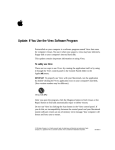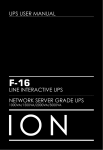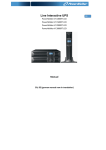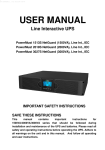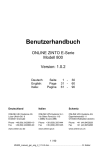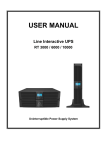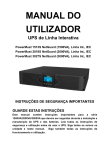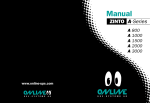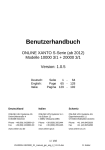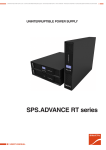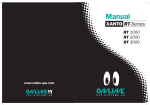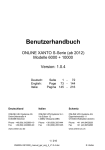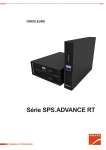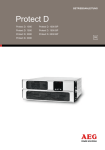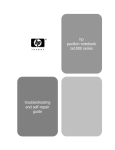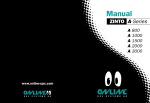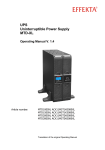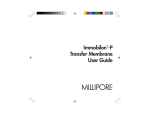Download Benutzerhandbuch
Transcript
Benutzerhandbuch ONLINE ZINTO E-Serie Modelle 1000 – 3000 Version: 1.0.2 Deutsch: English: Italia: Seite Page Pagina 1 - 40 41 - 80 81 - 120 Deutschland Italien Schweiz ONLINE USV-Systeme AG Luise-Ullrich-Str. 8 D-82031 Grünwald ONLINE UPS-Systems S.r.l. Via Ferruccio Gilera 110 I-20862 Arcore (MB) ONLINE USV-Systeme AG Eigenheimstraße 11 CH-8304 Wallisellen (Zürich) Phone +49 (89) 2423990-10 Fax +49 (89) 2423990-20 Phone +39 (039) 2051444 Fax +39 (039) 2051435 Phone Fax www.online-usv.de www.online-ups.it www.online-usv.ch +41 (44) 9452829 +41 (44) 9453288 1 / 120 ZE1000-3000_manual_ger_eng_it_V1.0.2.doc ............................................................... R. Kistler 2 / 120 ZE1000-3000_manual_ger_eng_it_V1.0.2.doc ............................................................... R. Kistler Inhalt Benutzerhandbuch ............................................................................. 1 1. Einleitung .................................................................................... 6 2. Sicherheitswarnungen ................................................................ 8 3. Montage ...................................................................................... 9 3.1 Überprüfung der Lieferung .................................................. 9 3.2 Auspacken der USV-Anlage ............................................... 9 3.3 Überprüfung des Zubehörs ............................................... 10 3.4 Installation als Tower ........................................................ 10 3.5 Installation im Rack ........................................................... 11 3.6 Inbetriebnahme ................................................................. 13 4. Betrieb ...................................................................................... 14 4.1 Bedienfeld ......................................................................... 14 4.2 Display ............................................................................... 15 4.3 Einstellungen ..................................................................... 16 4.4 Betriebszustände............................................................... 18 4.5 Starten und Abschalten ..................................................... 19 5. Kommunikation ......................................................................... 21 5.1 RS-232- und USB-Schnittstelle ......................................... 21 5.2 Potenzialfreie Kontakte ..................................................... 22 5.3 Slot für Schnittstellenkarten .............................................. 22 5.4 Notaus-Funktion (EPO) ..................................................... 23 5.5 DataWatch Software ......................................................... 24 5.6 USB für HID Power Devices ............................................. 24 6. Wartung .................................................................................... 25 6.1 Pflege und Wartung .......................................................... 25 6.2 Lagerung ........................................................................... 25 6.3 Zeitpunkt für den Batteriewechsel ..................................... 25 6.4 Batteriewechsel ................................................................. 26 6.5 Testen der neuen Batterien ............................................... 29 6.6 Entsorgen der Altbatterien oder der USV-Anlage ............. 30 7. Fehlerbehebung ....................................................................... 31 7.1 Warnmeldungen ................................................................ 31 7.2 Allgemeine Fehler ............................................................. 32 7.3 Stummschalten des Alarms .............................................. 32 7.4 Support .............................................................................. 33 3 / 120 ZE1000-3000_manual_ger_eng_it_V1.0.2.doc ............................................................... R. Kistler 8. Technische Daten .................................................................... 34 8.1 Spezifikation ...................................................................... 34 8.2 Rückansicht ....................................................................... 35 8.3 CE Bestätigung ................................................................. 37 9. Garantie .................................................................................... 38 4 / 120 ZE1000-3000_manual_ger_eng_it_V1.0.2.doc ............................................................... R. Kistler Abbildungsverzeichnis Abbildung 1: Prinzipschaltplan ............................................................. 6 Abbildung 2: ZINTO E 1000 - 3000 im Rack ........................................ 7 Abbildung 3: ZINTO E 1000 - 3000 als Tower...................................... 7 Abbildung 4: Installation als Tower ..................................................... 10 Abbildung 5: Entfernen der Frontblende............................................. 11 Abbildung 6: Befestigung im Rack ...................................................... 12 Abbildung 7: Bedienfeld (Modell ZINTO E 1000) .............................. 14 Abbildung 8: RS-232-Schnittstelle (DB-9-Stecker) ............................. 21 Abbildung 9: Beispielschaltung Optokoppler ...................................... 22 Abbildung 10: EPO-Stecker ................................................................ 23 Abbildung 11: Entfernen der Frontblende........................................... 27 Abbildung 12: Trennen der Batterie-Steckverbindung ....................... 28 Abbildung 13: Entfernen der Batterieabdeckung ................................ 28 Abbildung 14: Entnahme des Batterieeinschubes .............................. 28 Abbildung 15: Rückansicht ZINTO E 1000 ......................................... 35 Abbildung 16: Rückansicht ZINTO E 1500 und 2000 ......................... 36 Abbildung 17: Rückansicht ZINTO E 3000 ......................................... 36 Tabellenverzeichnis Tabelle 1: Lieferumfang ...................................................................... 10 Tabelle 2: Anzeigebeschreibungen .................................................... 14 Tabelle 3: Display ............................................................................... 15 Tabelle 4: Übersicht Betriebsstatus .................................................... 16 Tabelle 5: Einstellungen ..................................................................... 17 Tabelle 6: Anschlussstiftbelegung der RS-232 .................................. 21 Tabelle 7: Schnittstellenkarten ........................................................... 22 Tabelle 8: Warnmeldungen ................................................................ 31 Tabelle 9: Allgemeine Fehler .............................................................. 32 Tabelle 10: Spezifikationen ................................................................ 35 5 / 120 ZE1000-3000_manual_ger_eng_it_V1.0.2.doc ............................................................... R. Kistler EINLEITUNG 1. Einleitung Die ONLINE USV-Systeme AG (ONLINE) gehört zu den führenden Herstellern von unterbrechungsfreien Stromversorgungen (USV). Seit 1988 beschäftigt sich das deutsche Unternehmen mit Entwicklung, Fertigung, Vertrieb und Support von USV-Systemen. Nach verkauften Stückzahlen sind die Produkte der ONLINE die deutsche Nummer eins im USV-Markt und wegen ihrer hohen Qualität und des exzellenten Supports international anerkannt. Das Versorgungsnetz fällt häufig dann aus, wenn man es am wenigsten erwartet. Auch kann die Qualität der Stromversorgung oft erheblichen Schwankungen unterliegen. Netzprobleme können dazu führen, dass kritische Daten zerstört werden, ungesicherte Daten verloren gehen und Hardware beschädigt wird. Teure Reparaturen und Ausfallstunden sind die Folge. Ob preissensitiver Einstiegsserver oder Highend-PC, Telefonanlage, Netzwerkperipherie oder NAS: ZINTO E schützt sensible Anwendungen vor Datenverlust und Betriebsstillstand. Zwei von vielen Highlights der ZINTO E sind eine Leistung von bis zu 3000VA bei nur zwei Höheneinheiten und die Bauart als RackTower-Kombisystem. Ein zusätzliches Plus an Sicherheit bietet die Buck-&-BoostFunktion: Sie überbrückt kurze Stromausfälle auf elektronischer Basis ohne Batterie. Dies verlängert die Lebenserwartung der Akkus und minimiert die laufenden Kosten. Abbildung 1: Prinzipschaltplan 6 / 120 ZE1000-3000_manual_ger_eng_it_V1.0.2.doc ............................................................... R. Kistler EINLEITUNG Daneben bietet die ZINTO E die folgenden Vorzüge: Rack-Tower-Kombimodell, nur 2HE Leises Betriebsgeräusch NAS-Kompatibilität Perfekte Sinus-Ausgangsspannung Wirkungsgrad von >96% EBM+ Ladetechnologie für 72 Monate Batterielebenserwartung Hot-Swap Batterie: Wechsel im laufenden Betrieb ohne Abschalten der Verbraucher RS-232- und USB-Schnittstelle Generator-Kompatibilität Kaltstartfunktion Slot für optionalen SNMP-Adapter (nicht ZINTO E1000) Notaus-Funktion (EPO = Emergency Power-Off) (nicht ZINTO E1000) 2 Jahre Garantie inkl. Batterie Abbildung 2: ZINTO E 1000 - 3000 im Rack Abbildung 3: ZINTO E 1000 3000 als Tower 7 / 120 ZE1000-3000_manual_ger_eng_it_V1.0.2.doc ............................................................... R. Kistler SICHERHEITSWARNUNGEN 2. Sicherheitswarnungen Dieses Handbuch enthält wichtige Anweisungen, die Sie während der Installation und Wartung der USV-Anlage und der Batterien befolgen müssen. Bitte lesen Sie alle Anweisungen des Handbuches, bevor sie mit dem Gerät arbeiten. Bewahren Sie das Handbuch auf. ACHTUNG Die USV-Anlage führt lebensgefährliche Spannungen. Alle Reparatur- und Wartungsarbeiten sollten nur von Kundendienstfachleuten durchgeführt werden Die USV-Anlage enthält eine eigene Energiequelle (Batterien). Der Ausgang der USV-Anlage kann Spannung führen, auch wenn die USV-Anlage nicht an eine Wechselstromquelle angeschlossen ist Um Brandgefahr oder das Risiko eines elektrischen Schlages zu verringern, darf die USV-Anlage nur in Gebäuden mit kontrollierter Temperatur und Luftfeuchtigkeit installiert werden, in denen keine leitenden Schmutzstoffe vorhanden sind. Die Umgebungstemperatur darf 40°C nicht übersteigen. Die USV-Anlage darf nicht in der Nähe von Wasser oder in extrem hoher Luftfeuchtigkeit (>80%) betrieben werden Vergewissern Sie sich vor dem Transport der USV-Anlage, dass die USV-Anlage von der Stromversorgung getrennt und ausgeschaltet ist Batterien können das Risiko eines elektrischen Schlags bergen oder durch hohen Kurzschlussstrom in Brand geraten. Bitte treffen Sie die erforderlichen Vorsichtsmaßnahmen. Die Wartung muss von qualifiziertem Personal durchgeführt werden, das im Umgang mit Batterien geübt ist und über gute Kenntnisse der erforderlichen Vorsichtsmaßnahmen verfügt (siehe Wartung). Halten Sie nicht autorisiertes Personal von Batterien fern Die Batterien müssen ordnungsgemäß entsorgt werden. Hierbei sind die örtlichen Bestimmungen zu beachten Batterien dürfen nicht verbrannt werden. Es besteht Explosionsgefahr 8 / 120 ZE1000-3000_manual_ger_eng_it_V1.0.2.doc ............................................................... R. Kistler MONTAGE 3. Montage 3.1 Überprüfung der Lieferung Bewahren Sie die Transportkartons und das Verpackungsmaterial für die Spedition oder die Verkaufsstelle auf. Falls Anlagenteile während des Transports beschädigt wurden, reichen Sie innerhalb von 24 Stunden eine Transportschaden-Reklamation bei Ihrem Lieferanten ein. Wenn Sie eine Beschädigung erst nach der Annahme des Gerätes entdecken, reklamieren Sie diese bitte als verdeckten Schaden. 3.2 Auspacken der USV-Anlage ACHTUNG Falls die USV-Anlage bei niedriger Umgebungstemperatur ausgepackt wird, kann es zu Kondensatbildung innerhalb und außerhalb des Gehäuses kommen. Installieren Sie die USV-Anlage nur, wenn Innen- und Außenseite vollständig trocken sind (Gefahr eines elektrischen Schlages) Die USV-Anlage hat ein hohes Gewicht (siehe Technische Daten). Vorsicht beim Auspacken und Transportieren der USV HINWEIS Bewegen und öffnen Sie die verpackte USV-Anlage vorsichtig. Lassen Sie die Komponenten in der Verpackung, bis diese installiert werden. Zum Auspacken des Gehäuses und des Zubehörs: 1. Öffnen Sie den äußeren Karton und nehmen Sie die mit der USV-Anlage verpackten Zubehörteile heraus. 2. Heben Sie die USV-Anlage vorsichtig aus dem äußeren Karton. 3. Platzieren Sie die USV-Anlage an einer geschützten, ausreichend belüfteten Stelle, die von Feuchtigkeit, brennbaren Gasen und Korrosion frei ist. 9 / 120 ZE1000-3000_manual_ger_eng_it_V1.0.2.doc ............................................................... R. Kistler MONTAGE 3.3 Überprüfung des Zubehörs 19“-Montagewinkel (links und rechts) 2 Füße für Tower-Montage 2 RS-232 Schnittstellenkabel 1 USB Schnittstellenkabel 1 3 (ZINTO E 1000 + 1500 + 2000) 2 (ZINTO E 3000) 10A Kaltgeräteverlängerung 16A Netzanschlusskabel 1 (nur ZINTO E 3000) Software DataWatch 1 Bedienungsanleitung 1 Tabelle 1: Lieferumfang 3.4 Installation als Tower Die USV-Anlage wird vollständig zusammengebaut und anschlussfertig geliefert. ACHTUNG Das Gehäuse hat ein hohes Gewicht (siehe Technische Daten). 1. Schieben Sie die USVAnlage vertikal in die beiden Füße (siehe Abbildung 4). Achten Sie auf einen möglichst großen Abstand zwischen den Füßen, um hohe Stabilität zu gewährleisten. Abbildung 4: Installation als Tower 2. Fahren Sie mit dem Abschnitt Inbetriebnahme fort. 10 / 120 ZE1000-3000_manual_ger_eng_it_V1.0.2.doc ............................................................... R. Kistler MONTAGE 3.5 Installation im Rack Die USV-Anlage wird vollständig zusammengebaut und anschlussfertig geliefert. ACHTUNG Das Gehäuse hat ein hohes Gewicht (siehe Technische Daten). Für das Rack-Modell werden optionale Gleitschienen (Art.-Nr. RackKit) angeboten. Die Gleitschienen sind passend für 48 cm (19 Zoll) Racks mit einer Bautiefe von 61 bis 76 cm (24 bis 30 Zoll). 1. Montage des Rack-Kits (siehe separate Montageanleitung). 2. Entfernen Sie die Frontblende (siehe Abbildung 5). Lösen Sie zuerst die beiden Schrauben an der rechten Seite der Blende. Schieben Sie danach die Blende nach links. Abbildung 5: Entfernen der Frontblende 3. Drücken Sie die Plastikklammern auseinander und ziehen Sie das Display aus der Befestigung. Drehen Sie es gegen den Uhrzeigersinn um 90 Grad und stecken Sie es wieder in der Frontblende. 4. Setzen Sie die Frontblende wieder ein. Schieben Sie die Blende nach rechts, bis sie in der Halterung an der linken Seite des Gehäuses einrastet. Bringen Sie die beiden Schrauben an der rechten Seite der Frontblende wieder an. 5. Stellen Sie die USV-Anlage auf eine ebene, stabile Oberfläche. Die Vorderseite des Gehäuses ist zu Ihnen gerichtet 11 / 120 ZE1000-3000_manual_ger_eng_it_V1.0.2.doc ............................................................... R. Kistler MONTAGE 6. Richten Sie die Montagewinkel (L = Links und R = Rechts) mit den Schraubenbohrungen auf jeder Seite der USV-Anlage aus und befestigen Sie diese mit den beigefügten M4 x 8 Flachkopfschrauben. 7. Schieben Sie die USV-Anlage in das Rack. 8. Befestigen Sie die Montagewinkel der USV-Anlage am Rack (siehe Abbildung 6). Abbildung 6: Befestigung im Rack 9. Fahren Sie mit dem Abschnitt Inbetriebnahme fort. 12 / 120 ZE1000-3000_manual_ger_eng_it_V1.0.2.doc ............................................................... R. Kistler MONTAGE 3.6 Inbetriebnahme HINWEIS Vergewissern Sie sich, dass die Gesamtnennleistung aller angeschlossenen Verbraucher die Kapazität der USVAnlage nicht überschreitet. 1. Verbinden Sie die Verbraucher mit der USV-Anlage, ohne die Verbraucher einzuschalten. 2. Stecken Sie das Netzanschlusskabel (bei ZINTO E 3000 im Lieferumfang) für die USV-Anlage in eine Steckdose. Das Display der USV-Anlage leuchtet auf und zeigt „STbY“ an. 3. Halten Sie die Taste an der USV-Anlage mindestens drei Sekunden lang gedrückt. 4. Falls die Anzeige aufleuchtet, beheben Sie alle Warnmeldungen und starten Sie die USV-Anlage ggfs. neu. (siehe Fehlerbehebung). 5. Vergewissern Sie sich, dass im Display „NORM“ angezeigt wird. Dadurch wird signalisiert, dass die USV-Anlage im Normalbetrieb arbeitet und die Verbraucher mit Strom versorgt werden. HINWEIS Beim ersten Starten wird die Ausgangsfrequenz auf den Wert der Eingangsfrequenz gesetzt (die automatische Erkennung ist standardmäßig aktiviert). 6. Falls ein zusätzlicher Notaus-Schalter installiert wurde, muss die Notaus-Funktion geprüft werden. 7. Schalten Sie die Verbraucher der Reihe nach ein. HINWEIS Die internen Batterien lassen sich in weniger als drei Stunden auf 90% ihrer Kapazität aufladen. ONLINE empfiehlt, die Batterien nach der Installation oder nach längerer Lagerung 48 Stunden lang aufzuladen. 13 / 120 ZE1000-3000_manual_ger_eng_it_V1.0.2.doc ............................................................... R. Kistler BETRIEB 4. Betrieb 4.1 Bedienfeld Die USV-Anlage verfügt über ein Bedienfeld mit 4 Tasten und ein grafisches Display (siehe Abbildung 7). Im Normalbetrieb leuchtet die Hintergrundbeleuchtung blau. Bei wichtigen Warnmeldungen rot. Abbildung 7: Bedienfeld (Modell ZINTO E 1000) Taste Funktion Einschalten / Ausschalten Funktionstest Batterietest Alarmsignal AUS Taste länger als 3s gedrückt halten Eingangsspannung trennen und Taste länger als 3s gedrückt halten Taste länger als 3s gedrückt halten Taste länger als 10s gedrückt halten Taste kurz drücken Scrollen Taste kurz drücken Einstellmodus auswählen Einstellung auswählen Einstellung bestätigen Einstellmodus verlassen Taste länger als 3s gedrückt halten Taste länger als 1s gedrückt halten Taste länger als 1s gedrückt halten Taste länger als 3s gedrückt halten Ausschalten bei Fehler Tabelle 2: Anzeigebeschreibungen HINWEIS Beim Funktions- bzw. Batterietest müssen die Batterien vollgeladen sein und die USV-Anlage muss sich im Normalbetrieb befinden. 14 / 120 ZE1000-3000_manual_ger_eng_it_V1.0.2.doc ............................................................... R. Kistler BETRIEB 4.2 Display Symbol Beschreibung Funktion Eingangsspannung u. -frequenz Zeigt abwechselnd die Eingangsspannung und –frequenz an Eingangsstecker Signalisiert den Eingangsstecker Ausgangsspannung u. -frequenz Zeigt abwechselnd die Ausgangsspannung und –frequenz an Ausgangsbuchsen Signalisiert die Ausgangsbuchsen USV Status Zeigt den USV Status an. Siehe Tabelle 4 Warnmeldung Leuchtet auf, wenn Warnmeldung vorliegt. Siehe Warnmeldungen Einstellungen Leuchtet auf, wenn Menü Einstellungen aktiviert ist. Siehe Einstellungen Batterieanzeige Zeigt die aktuelle Kapazität der Batterie an. Jedes Segment entspricht 20%. Wenn alle Segmente leuchten ist die Batterie zu 100% geladen. Lastanzeige Zeigt die aktuelle Last an. Jedes Segment entspricht 20%. Wenn alle Segmente leuchten ist die USV-Anlage zu 100% ausgelastet. Tabelle 3: Display HINWEIS Die Anzeige schaltet nach drei Minuten ohne Betätigung ab. 15 / 120 ZE1000-3000_manual_ger_eng_it_V1.0.2.doc ............................................................... R. Kistler BETRIEB String Beschreibung STbY IPVL IPVH IPFL IPFH NORM USV-Anlage im Standby-Betrieb Eingangsspannung zu niedrig Eingangsspannung zu hoch Eingangsfrequenz zu niedrig Eingangsfrequenz zu hoch USV-Anlage im Normalbetrieb USV-Anlage im Normalbetrieb, zusätzlich Buck-&-Boost-Funktion USV-Anlage im Batteriebetrieb Funktions- oder Batterietest läuft Ausgangsspannung zu hoch Ausgangsspannung zu niedrig Kurzschluss am Ausgang der USV-Anlage Überlast am Ausgang der USV-Anlage Batteriespannung zu hoch Batteriespannung zu niedrig Interne Temperatur zu hoch Lüfter blockiert Batterien schwach AVR bATT TEST OPVH OPVL OPST OVLD bATH bATL OVTP FNLK bTWK Tabelle 4: Übersicht Betriebsstatus 4.3 Einstellungen 1. Einstellungsmodus auswählen: Taste 3s gedrückt halten. 2. Scrollen zwischen den Einstellungen: Taste drücken bis gewünschte Einstellung erscheint (siehe Tabelle 5). 3. Einstellung auswählen: Taste lung blinkt jetzt. 4. Einstellung ändern: Taste erscheint (siehe Tabelle 5). 1s gedrückt halten. Einsteldrücken bis gewünschte Option 5. Einstellung bestätigen: Taste 6. Einstellmodus verlassen: Taste 1s gedrückt halten. 3s gedrückt halten. 16 / 120 ZE1000-3000_manual_ger_eng_it_V1.0.2.doc ............................................................... R. Kistler BETRIEB Einstellung Verfügbare Optionen Standard OPV [220]=220V [230]=230V [240]=240V „230V“ [000]= Normal = ±20% Eingangsspannungstoleranz [001]= Weitbereich = +20% / -30% Eingangsspannungstoleranz [002]= Generator = 40Hz – 70Hz Eingangsfrequenztoleranz „Normal“ [000]=deaktiviert [001]=aktiviert „aktiviert“ [000]=deaktiviert [001]=aktiviert „aktiviert“ [000]=deaktiviert [001]=aktiviert „aktiviert“ [000]=ausgeschaltet [001]=eingeschaltet „eingeschaltet“ [000]=ausgeschaltet [001]=eingeschaltet „eingeschaltet“ Ausgangsspannung AVR Eingang TEST Automatische Selbsttests AR Automatischer Neustart bZ Alarm LS1 Lastsegment 1 (nicht ZINTO E 1000) LS2 Lastsegment 2 (nicht ZINTO E 1000) Tabelle 5: Einstellungen 17 / 120 ZE1000-3000_manual_ger_eng_it_V1.0.2.doc ............................................................... R. Kistler BETRIEB 4.4 Betriebszustände Der Status der USV-Anlage wird auf dem Bedienfeld angezeigt. Normalbetrieb Im Normalbetrieb wird im Display „NORM“ angezeigt und die USVAnlage vom Versorgungsnetz gespeist. Die USV-Anlage überwacht die Batterien und lädt diese je nach Bedarf auf. Die angeschlossenen Verbraucher werden mit Strom versorgt. Falls im Display „AVR“ angezeigt wird, arbeitet die USV-Anlage zusätzlich in der Buck-&-Boost-Funktion. Die Über- oder Unterspannung im Versorgungsnetz wird automatisch durch die Elektronik der USV-Anlage ausgeglichen. Batteriebetrieb Im Batteriebetrieb wird im Display „bATT“ angezeigt und der Alarm ertönt alle vier Sekunden. Die angeschlossenen Verbraucher werden über die Batterie mit Strom versorgt. Ist der Batterieladezustand im Batteriebetrieb niedrig, wird im Display „bATL“ angezeigt und der Alarm ertönte jede Sekunde. Die verbleibende Überbrückungszeit ist gering. Schließen Sie alle Anwendungen, da die automatische Abschaltung der USV-Anlage kurz bevorsteht. Ist der Batterie im Batteriebetrieb erschöpft, schaltet sich die USVAnlage ab. Alle Anzeigen und der Alarm sind ausgeschaltet. Kehrt das Versorgungsnetz nach dem Abschalten der USV-Anlage zurück, wird die USV-Anlage automatisch neu gestartet (wenn in den Einstellungen so konfiguriert). Die Batterien werden geladen und die angeschlossenen Verbraucher mit Strom versorgt. Standby-Betrieb Bei ausgeschalteter USV-Anlage und angeschlossenem Netzanschlusskabel läuft die USV-Anlage noch immer im Standby-Betrieb. Im Display wird „STbY“ angezeigt. Für die angeschlossenen Verbraucher ist kein Strom verfügbar. Die Batterie wird bei Bedarf geladen. 18 / 120 ZE1000-3000_manual_ger_eng_it_V1.0.2.doc ............................................................... R. Kistler BETRIEB 4.5 Starten und Abschalten 1. Stecken Sie das Netzanschlusskabel (bei ZINTO E 3000 im Lieferumfang) der USV-Anlage in eine Steckdose. Das Display an der USV-Anlage leuchtet auf und „STbY“ wird angezeigt. 2. Halten Sie die Taste an der USV-Anlage für mindestens drei Sekunden lang gedrückt. 3. Falls die Anzeige aufleuchtet, beheben Sie alle Warnmeldungen und starten die USV-Anlage ggfs. neu. (siehe Fehlerbehebung). 4. Vergewissern Sie sich, dass im Display „NORM“ angezeigt wird. Die USV-Anlage arbeitet im Normalbetrieb und versorgt die Verbraucher mit Strom. Starten im Batteriebetrieb HINWEIS Um die Ausgangsfrequenz von 50 oder 60Hz zu aktivieren, muss die USV-Anlage vor der erstmaligen Verwendung des Batteriebetriebs mindestens einmal vom Netz versorgt und gestartet worden sein. 1. Halten Sie die Taste Display aufleuchtet. an der USV-Anlage gedrückt, bis das Die USV-Anlage durchläuft den Selbsttest. Das Display zeigt „bATT“ an. Die USV-Anlage versorgt die angeschlossenen Verbraucher mit Strom. 2. Falls die Anzeige aufleuchtet, beheben Sie alle Warnmeldungen und starten Sie die USV-Anlage ggfs. neu. (siehe Fehlerbehebung). 19 / 120 ZE1000-3000_manual_ger_eng_it_V1.0.2.doc ............................................................... R. Kistler BETRIEB Abschalten 1. Halten Sie die Taste lang gedrückt. an der USV-Anlage drei Sekunden Die USV-Anlage gibt ein kurzes akustisches Signal. Die USVAnlage wechselt in den Standby-Betrieb und das Display zeigt „STbY“ an. HINWEIS Wird die Taste nach weniger als drei Sekunden losgelassen, so kehrt die USV-Anlage wieder zu ihrer vorherigen Betriebsart zurück. 2. Ziehen Sie das Netzanschlusskabel der USV-Anlage aus der Steckdose. Das Display der USV-Anlage erlischt nach kurzer Zeit und die USV-Anlage schaltet sich komplett aus. 20 / 120 ZE1000-3000_manual_ger_eng_it_V1.0.2.doc ............................................................... R. Kistler KOMMUNIKATION 5. Kommunikation 5.1 RS-232- und USB-Schnittstelle Um die Kommunikation zwischen der USV-Anlage und einem Computer herzustellen, schließen Sie den Computer mithilfe eines geeigneten Datenkabels (Kabel im Lieferumfang) an die RS-232- oder USB-Schnittstelle der USV-Anlage an (siehe Abbildung 15, Abbildung 16 und Abbildung 17). HINWEIS Die RS-232- und USB-Kommunikationsschnittstelle können nicht gleichzeitig verwendet werden. Danach kann die USV-Anlage Daten über die DataWatch Software (siehe „DataWatch Software“) austauschen. Mittels USB-Protokoll besteht auch die Möglichkeit des direkten Datenaustauschs ohne Softwareinstallation (siehe „USB für HID Power Device“). Die Belegung der Kabelanschlussstifte für die RS-232-Kommunikationsschnittstelle ist in Abbildung 8 dargestellt, die Funktionen der Anschlussstifte entnehmen Sie Tabelle 6. Abbildung 8: RS-232-Schnittstelle (DB-9-Stecker) Pin 1 2 3 4, 6, 7, 9 5 8 Funktion Batterie leer bei Batteriebetrieb (Schließer, Kontakt zu Pin 5) Daten senden (TxD) Daten empfangen (RxD) Nicht verwendet Masse Batteriebetrieb (Schließer, Kontakt zu Pin 5) Tabelle 6: Anschlussstiftbelegung der RS-232 21 / 120 ZE1000-3000_manual_ger_eng_it_V1.0.2.doc ............................................................... R. Kistler KOMMUNIKATION 5.2 Potenzialfreie Kontakte Die potenzialfreien Kontakte (nicht ZINTO E 1000) zwischen Pin 1 und Pin 5 bzw. Pin 8 und Pin 5 sind als Optokoppler ausgeführt. Damit der potenzialfreie Kontakt ordnungsgemäß arbeitet muss eine Gleichspannung (max. 40V) von außen anliegen, wie in folgender Beispielschaltung dargestellt (siehe Abbildung 9). Abbildung 9: Beispielschaltung Optokoppler Optokoppler können nur kleine Ströme (max. 70mA) schalten. Wird eine Last mit höherem Stromverbrauch angeschlossen, muss ein Relais zwischen Optokoppler und Last geschaltet werden. 5.3 Slot für Schnittstellenkarten Die ZINTO E (nicht ZINTO E 1000) ist mit einem Slot (siehe Abbildung 16 und Abbildung 17) für die folgenden Schnittstellenkarten ausgestattet: Art.-Nr. DW7SNMP30 DW5SNMP30 Beschreibung SNMP-Adapter Basic Der SNMP-Adapter kommuniziert via TCP/IP mit den angeschlossenen Verbrauchern im Netzwerk. SNMP-Adapter Professional Funktion wie Basic, jedoch mit zusätzlicher Schnittstelle für Temperaturfühler und Gebäudemanagement. Tabelle 7: Schnittstellenkarten 22 / 120 ZE1000-3000_manual_ger_eng_it_V1.0.2.doc ............................................................... R. Kistler KOMMUNIKATION 5.4 Notaus-Funktion (EPO) Die Notaus-Funktion (EPO = Emergency Power-Off) dient zum sofortigen Abschalten der USV-Anlage und der angeschlossenen Verbraucher aus der Ferne. Hierzu muss der EPO-Stecker (Rückseite USV-Anlage, siehe Abbildung 10) entfernt und ein externer NotausSchalter angeschlossen werden. 2 Kabelquerschnitt Anschlusskabel = 0,32 - 4mm (AWG 22 - 12) 2 Empfohlener Kabelquerschnitt Anschlusskabel = 1,5mm (AWG 18) ACHTUNG Der Notaus-Schalter darf nicht an Schaltkreise angeschlossen werden, die mit dem Versorgungsnetz verbunden sind. Eine verstärkte Isolierung zum Netz ist erforderlich. Der Notaus-Schalter muss mindestens für 24V und 20mA ausgelegt sein. Es muss ein Öffner verwendet werden. Für den ordnungsgemäßen Betrieb muss die Notaus-Funktion mindestens 250ms lang aktiv bleiben Wenn die die Notaus-Funktion aktiviert wird, muss zusätzlich die Eingangsspannung der USV-Anlage unterbrochen werden HINWEIS Lassen Sie den EPO-Stecker im Notaus-Anschluss an der USV-Anlage eingesteckt, wenn die Notaus-Funktion nicht benötigt wird Testen Sie die Notaus-Funktion immer, bevor eine kritische Last angeschlossen wird. Hiermit vermeiden Sie eine versehentliche Lastabschaltung Abbildung 10: EPO-Stecker Zur Lage des EPO-Steckers siehe Abbildung 16 und Abbildung 17. 23 / 120 ZE1000-3000_manual_ger_eng_it_V1.0.2.doc ............................................................... R. Kistler KOMMUNIKATION 5.5 DataWatch Software Zum serienmäßigen Lieferumfang der ZINTO E-Serie gehört DataWatch, die umfassende Softwarelösung zum Shutdown und Management des PC- oder Serversystems, sowie zum Monitoring der ZINTO E und des Stromversorgungsnetzes. DataWatch arbeitet im Hintergrund und kommuniziert ständig über RS-232-, USB- oder Netzwerk-Protokoll mit der ZINTO E. Die bekannteste aller Funktionen: Automatische Datensicherung mit dem Schließen laufender Anwendungen und dem geordneten Herunterfahren des gesamten Systems mittels frei konfigurierbarer Shutdownroutine. Darüber hinaus verfügt DataWatch über ein umfangreiches Messaging-System, zeitgesteuerte Testroutinen sowie eine Ereignisprotokollierung. DataWatch unterstützt alle aktuellen Betriebssysteme. Als Client- / Server-Anwendung arbeitet DataWatch in Netzwerken und auf lokalen Workstations. Mittels optionalem RCCMD-Agent (Remote Console Command) lassen sich mehrere an einer USVAnlage angeschlossene Server ohne zusätzliche Hardware über das Netzwerk ansprechen und steuern. 5.6 USB für HID Power Devices Die USB-Schnittstelle ist mit dem Standard Protokoll „Human Interface Device (HID)“ versehen. Über dieses Protokoll können verschiedene Geräte (z.B. NAS) direkt mit der USV-Anlage verbunden werden. Zusätzliche Software (z.B. DataWatch) ist hierfür nicht notwendig. Die Kommunikation mit der USV-Anlage erfolgt über die integrierte Hardware Steuerung in den angeschlossenen Geräten. 24 / 120 ZE1000-3000_manual_ger_eng_it_V1.0.2.doc ............................................................... R. Kistler WARTUNG 6. Wartung 6.1 Pflege und Wartung Für eine lange Lebensdauer der Anlage sollte der Bereich um die USV-Anlage sauber und staubfrei sein. Falls es in der Umgebung der Anlage sehr staubig ist, reinigen Sie die Außenflächen der Anlage mit einem Staubsauger. Um eine lange Lebensdauer der Batterien zu erreichen, sollte die Umgebungstemperatur unter 25°C betragen. HINWEIS Vergewissern Sie sich vor dem Transport der USV-Anlage, dass die USV-Anlage vom Versorgungsnetz getrennt und ausgeschaltet ist Die Lebensdauer einer Batterie variiert je nach Nutzungshäufigkeit und Umgebungstemperatur. Nach Ablauf der zu erwartenden Lebensdauer haben weiter verwendete Batterien häufig deutlich verringerte Laufzeiten. Tauschen Sie die Batterien rechtzeitig aus, damit die Anlage immer mit optimaler Leistung laufen kann 6.2 Lagerung Falls Sie die USV-Anlage über längere Zeit lagern, laden Sie die Batterie alle sechs Monate auf, indem Sie die USV-Anlage an das Versorgungsnetz anschließen. Die internen Batterien laden sich in weniger als drei Stunden auf bis zu 90% ihrer Kapazität auf. ONLINE empfiehlt, die Batterien nach längerer Lagerung (>3 Monate) 48 Stunden lang zu laden. 6.3 Zeitpunkt für den Batteriewechsel Wenn das Display rot aufleuchtet, im Display „bTWK“ angezeigt wird und das Alarmsignal dauerhaft zu hören ist, müssen die Batterien ausgetauscht werden. Wenden Sie sich an Ihren Händler oder ONLINE, (www.usvshop24.de) um neue Batterien zu bestellen. 25 / 120 ZE1000-3000_manual_ger_eng_it_V1.0.2.doc ............................................................... R. Kistler WARTUNG 6.4 Batteriewechsel HINWEIS Entfernen Sie die Batterien nicht, solange die USV-Anlage im Batteriebetrieb läuft. Dank der Hot-Swap-Funktion können die Batterien ohne vorheriges Abschalten der USV-Anlage und ohne Trennen der angeschlossenen Verbraucher ausgetauscht werden. Falls Sie die USV-Anlage vor dem Batteriewechsel lieber vom Netz trennen möchten, lesen Sie den Abschnitt „Starten und Abschalten“. ACHTUNG Wartungsarbeiten sollten durch einen qualifizierten Techniker durchgeführt werden, der mit Batterien und den nötigen Sicherheitsvorkehrungen vertraut ist. Halten Sie unbefugtes Personal von den Batterien fern Batterien bergen das Risiko eines elektrischen Schlags oder einer Verletzung durch hohe Kurzschlussströme. Halten Sie folgende Sicherheitsvorkehrungen ein: o Nehmen Sie Uhren, Schmuck und andere Metallgegenstände ab o Verwenden Sie nur Werkzeug mit isolierten Griffen o Legen Sie Werkzeuge oder Metallteile nicht auf den Batterien ab Die Batterien dürfen nur gegen die gleiche Anzahl typgleicher Batterien ausgetauscht werden Batterien müssen sachgemäß entsorgt werden. Richten Sie sich bei der Entsorgung nach den örtlich geltenden gesetzlichen Bestimmungen Batterien dürfen nicht verbrannt werden. Es besteht Explosionsgefahr Öffnen oder beschädigen Sie die Batterie(n) nicht. Die Batteriesäure kann Augen und Haut angreifen, sowie Vergiftungen bewirken 26 / 120 ZE1000-3000_manual_ger_eng_it_V1.0.2.doc ............................................................... R. Kistler WARTUNG ACHTUNG GEFAHR EINES ELEKTRISCHEN SCHLAGS. Nehmen Sie auf keinen Fall selbst Veränderungen an der Verkabelung oder den Anschlüssen der Batterie vor. Der Versuch, eigenständig die Verkabelung der Batterie zu verändern, kann zu ernsthaften Verletzungen führen Die Batterien der USV-Anlage haben ein hohes Gewicht. Beim Umgang mit den schweren Batterien ist Vorsicht geboten Die Batterien befinden sich hinter der Frontblende der USV-Anlage. Die internen Batterien sind wegen der besseren Handhabung zusammen verpackt. 1. Entfernen Sie die Frontblende (siehe Abbildung 11). Lösen Sie zuerst die beiden Schrauben an der rechten Seite der Blende. Schieben Sie danach die Blende nach links. Abbildung 11: Entfernen der Frontblende HINWEIS Ein Flachbandkabel verbindet das Bedienfeld mit der USVAnlage. Ziehen Sie nicht an dem Kabel und trennen Sie die Verbindung nicht. 27 / 120 ZE1000-3000_manual_ger_eng_it_V1.0.2.doc ............................................................... R. Kistler WARTUNG 2. Trennen Sie die Batterie-Steckverbindung (siehe Abbildung 12). Abbildung 12: Trennen der Batterie-Steckverbindung 3. Entfernen Sie die Batterieabdeckung (siehe Abbildung 13). Abbildung 13: Entfernen der Batterieabdeckung 4. Ziehen Sie den Batterieeinschub vorsichtig am Griff heraus (siehe Abbildung 14) Abbildung 14: Entnahme des Batterieeinschubes 28 / 120 ZE1000-3000_manual_ger_eng_it_V1.0.2.doc ............................................................... R. Kistler WARTUNG 5. Tauschen Sie die Batterien im Batterieeinschub aus. HINWEIS Überprüfen Sie, ob die Ersatzbatterien dieselben Spezifikationen aufweisen wie die Altbatterien. Lesen Sie den Abschnitt Entsorgen der Altbatterien oder der USV-Anlage für eine sachgemäße Entsorgung. 6. Einbau des Batterieeinschubs in umgekehrter Reihenfolge. ACHTUNG Ein kleiner Lichtbogen kann auftreten, wenn die Batterien an die USV-Anlage angeschlossen werden. Das ist normal und kann nicht zur Gefährdung von Personen führen. Führen Sie das Kabel der Batterien schnell und kräftig in die BatterieSteckverbindung der USV-Anlage ein. 7. Fahren Sie mit dem Abschnitt Testen der neuen Batterien fort. 6.5 Testen der neuen Batterien 1. Schließen Sie die USV-Anlage zum Aufladen der Batterien für 48 Stunden an das Versorgungsnetz an. 2. Halten Sie die Taste 10s lang gedrückt, um den Batterietest zu starten. Im Display wird „TEST“ angezeigt. 3. Bei fehlerhaften Batterien wird automatisch eine Warnmeldung angezeigt (siehe Tabelle 4). HINWEIS Die USV-Anlage startet nur dann einen Batterietest, wenn die Batterien vollständig aufgeladen sind und die USVAnlage sich im Normalbetrieb ohne aktive Warnmeldungen befindet. 29 / 120 ZE1000-3000_manual_ger_eng_it_V1.0.2.doc ............................................................... R. Kistler WARTUNG 6.6 Entsorgen der Altbatterien oder der USV-Anlage Erkundigen Sie sich vor Ort bei einer Recycling-Stelle, wie die Altbatterie oder die USV-Anlage ordnungsgemäß entsorgt werden können. Altbatterien können auch kostenlos bei ONLINE entsorgt werden. Bitte kontaktieren Sie hierzu den Support (siehe Support). ACHTUNG Batterien dürfen nicht verbrannt werden. Es besteht Explosionsgefahr Batterien müssen ordnungsgemäß entsorgt werden. Informieren Sie sich über die Entsorgungsvorschriften vor Ort Öffnen oder beschädigen Sie die Batterie(n) nicht. Die Batteriesäure kann Augen und Haut angreifen, sowie Vergiftungen bewirken 30 / 120 ZE1000-3000_manual_ger_eng_it_V1.0.2.doc ............................................................... R. Kistler FEHLERBEHEBUNG 7. Fehlerbehebung Die ZINTO E ist für den selbstständigen Betrieb ausgelegt und meldet eventuell auftretende Probleme automatisch im Display. 7.1 Warnmeldungen Alarmsignal oder Status Mögliche Ursache Maßnahme Batteriebetrieb Ein Stromausfall ist aufgetreten und die USV-Anlage läuft im Batteriebetrieb. Die USV-Anlage versorgt die angeschlossene Last mit Batteriestrom. Bereiten Sie die angeschlossene Last auf das Herunterfahren vor. Die USV-Anlage läuft im Batteriebetrieb und der Batterieladestand ist niedrig. Die USV-Anlage versorgt die angeschlossene Last nur noch kurz mit Batteriestrom. Bereiten Sie die angeschlossene Last auf das unmittelbare Herunterfahren vor. Die Ausgangsleistung der USV-Anlage wird überschritten (> 105 %). Verringern Sie die angeschlossene Last. Kurzschluss am der USV-Anlage Entfernen Sie den Kurzschluss am Ausgang der USV-Anlage. bATT akustisches Signal alle 4s Batteriebetrieb Rotes Display bATL akustisches Signal jede s Überlast Rotes Display OVLD akustisches Signal jede s Kurzschluss Rotes Display Ausgang OPST akustisches Signal jede s USV-Anlage def. Rotes Display Die USV-Anlage hat einen internen Fehler. Wenden Sie sich an den Support. FAIL dauerhaft akustisches Signal Tabelle 8: Warnmeldungen 31 / 120 ZE1000-3000_manual_ger_eng_it_V1.0.2.doc ............................................................... R. Kistler FEHLERBEHEBUNG 7.2 Allgemeine Fehler Betriebszustand Die USV-Anlage stellt nicht die erwartete Zeit für die Datensicherung zur Verfügung. An den Ausgangsanschlüssen der USV-Anlage ist keine Spannung verfügbar. Mögliche Ursache Die Batterien müssen aufgeladen oder getauscht werden. Maßnahme Schließen Sie die USV-Anlage 48 Stunden an den Netzstrom an, um die Batterien aufzuladen. Wenden Sie sich an den Support. Die USV-Anlage Standbybetrieb. Die USV-Anlage wird nicht gestartet. Das Stromkabel ist nicht richtig angeschlossen. Der Notausschalter (EPOSchalter) ist aktiv oder der EPO-Anschluss fehlt. Die Verbraucher sind nicht richtig an die USV-Anlage angeschlossen. Stellen Sie die Stromversorgung für die angeschlossene Anlage her: Halten Sie den Ein-/Aus-Schalter mindestens zwei Sekunden lang gedrückt, bis auf dem Anzeigefeld Normalbetrieb angezeigt wird. Prüfen Sie die Anschlüsse des Netzkabels. Überprüfen Sie den NotausAnschluss. Die USV-Anlage läuft im Normalbetrieb, aber einige oder alle Verbraucher sind nicht eingeschaltet. Der Batterietest wurde nicht ausgeführt oder unterbrochen. ist im Eine der unter „Ausführen der automatischen Batterietests“ aufgeführten Voraussetzungen wurde nicht erfüllt. Überprüfen Sie, ob die Verbraucher mit den Anschlüssen der USVAnlage verbunden sind. Beheben Sie das Problem und starten Sie den Test erneut. Tabelle 9: Allgemeine Fehler 7.3 Stummschalten des Alarms Drücken Sie die Taste kurz, um den Alarm stumm zu schalten. Prüfen Sie den Status, der die Warnmeldung ausgelöst hat, und führen Sie geeignete Maßnahmen durch, um diesen Zustand zu beheben. Wenn sich der Status der Warnmeldung ändert, wird der Alarm wieder ausgegeben. Dieses hat Vorrang gegenüber der vorherigen Stummschaltung des Alarms. HINWEIS Die Alarme „Interne Temperatur zu hoch“, „Lüfter blockiert“ und „Batterien schwach“ können nicht stumm geschaltet werden. 32 / 120 ZE1000-3000_manual_ger_eng_it_V1.0.2.doc ............................................................... R. Kistler FEHLERBEHEBUNG 7.4 Support Als deutscher Anbieter garantiert ONLINE direkte Ansprechbarkeit, unbürokratische Bearbeitung und kürzeste Reaktionszeiten. Umfassende Unterstützung ist selbstverständlich – vor und nach dem Kauf. Bei ONLINE werden umfassende Support- und Serviceleistungen groß geschrieben. Direkte Beratung und Support kostenlos unter: Software-Hotline: +49 (89) 242 39 90 - 13 Hardware-Hotline: +49 (89) 242 39 90 - 18 Kostenloser 24h-Vorabaustausch Interaktiver USV-Konfigurator im Internet oder als App 2 Jahre Vollgarantie, optionale Verlängerung Unbürokratische 14 Tage Geld-zurück-Garantie Hohe Warenverfügbarkeit und dichtes Distributionsnetz Weitere Informationen: www.online-usv.de 33 / 120 ZE1000-3000_manual_ger_eng_it_V1.0.2.doc ............................................................... R. Kistler TECHNISCHE DATEN 8. Technische Daten 8.1 Spezifikation Modell Artikel-Nr. Elektrische Eigenschaften Nennleistung (VA/W) Technologie Eingangsspannung und Frequenzbereiche ohne Batterieeinsatz Ausgangsspannung und frequenz ZINTO E 1000 ZE1000 Batterien Typ. Überbrückungszeiten bei 50 bzw. 100% Last und pf=0,7 Batterietyp Ausführung Batterie-Management Kommunikation USB RS-232 Modem / Netzwerk Überspannungsschutz Potenzialfreie Kontakte über RS-232 SNMP-Slot EPO ZINTO E 2000 ZE2000 ZINTO E 3000 ZE3000 1000VA 1500VA 2000VA 3000VA 800W 1300W 1600W 2500W Line-interactive mit Sinusausgangsspannung und Buck&-Boost-Funktion 161 – 276V 45 – 55Hz (50Hz System), 55 – 65Hz (60Hz System) 40 – 70Hz (Generatorbetrieb) 230V (±5%) (Einstellbar auf 220V/230V/240V), Normalbetrieb 50/60Hz ±5Hz Batteriebetrieb 50/60Hz ±0,1Hz Anschlüsse Eingang Ausgänge ZINTO E 1500 ZE1500 1x IEC320 C14 (10A) 1x IEC320 C20 (16A) 8x IEC320 C13 (10A) zus.1x IEC320 C19 (16A) bei ZINTO E 3000 23 / 10min 20 / 9min 14 / 6min 14 / 6min 3x 4x 4x 6x 12V / 9Ah 12V / 9Ah 12V / 9Ah 12V / 9Ah Versiegelt, wartungsfrei, ventilgeregelt, Blei/Säure, Lebensdauer 3 - 5 Jahre gemäß EUROBAT EBM+, Automatischer Batterietest, Tiefentladungsschutz Ja, HID-Interface Ja Ja Nein Ja Nein Nein Ja Ja 34 / 120 ZE1000-3000_manual_ger_eng_it_V1.0.2.doc ............................................................... R. Kistler TECHNISCHE Betriebsbedingungen, Normen und Zulassungen Betriebstemperatur Relative Luftfeuchtigkeit Betriebshöhe Lagertemperatur Geräuschentwicklung Normalbetrieb Sicherheit EMV, Performance Zulassung Abmessungen / Gewicht Abmessungen liegend (B x H x T) Gewicht DATEN 0 - 40°C 20 - 80% nicht kondensierend bis 1.500 Meter über NN -15 - 45°C 34dB(A) Lautlos (ZE1000) (ZE1500, ZE2000, ZE3000) EN 62040-1 EN 62040-2 CE 438 x 86.5 x 436mm / 19" x 2HE x 436mm 16,6kg 20,5kg 20,5kg 438 x 86.5 x 605mm / 19" x 2HE x 605mm 30,4kg Tabelle 10: Spezifikationen 8.2 Rückansicht Abbildung 15: Rückansicht ZINTO E 1000 35 / 120 ZE1000-3000_manual_ger_eng_it_V1.0.2.doc ............................................................... R. Kistler TECHNISCHE DATEN HINWEIS Die Anschlüsse für Lastsegment 1 sind schraffiert dargestellt. Abbildung 16: Rückansicht ZINTO E 1500 und 2000 Abbildung 17: Rückansicht ZINTO E 3000 36 / 120 ZE1000-3000_manual_ger_eng_it_V1.0.2.doc ............................................................... R. Kistler TECHNISCHE DATEN 8.3 CE Bestätigung 37 / 120 ZE1000-3000_manual_ger_eng_it_V1.0.2.doc ............................................................... R. Kistler GARANTIE 9. Garantie Die ONLINE USV-Systeme AG (ONLINE) gewährleistet, dass dieses Produkt für die Dauer von zwei Jahren ab Kaufdatum frei von Material- und Fertigungsfehlern ist. Die Verpflichtung von ONLINE gemäß dieser Garantie ist auf die Reparatur oder den Ersatz (Entscheidung trifft ONLINE) jeglicher defekter Produkte begrenzt. Bevor unter die Garantie fallende Wartungsleistungen in Anspruch genommen werden können, muss beim Kundendienst eine Warenrücknahmenummer (Returned Material Authorization/---RMA) angefordert werden. Produkte müssen als vom Absender bezahlte Sendung zurückgeschickt werden, und eine kurze Beschreibung des aufgetretenen Problems sowie einen Nachweis von Ort und Datum des Kaufs enthalten. Diese Garantie gilt nicht für Geräte, die durch Unfall, Fahrlässigkeit oder Missbrauch beschädigt, oder in irgendeiner Weise verändert oder modifiziert wurden. Von hierin vorgesehenen Ausnahmen abgesehen, übernimmt ONLINE keinerlei ausdrückliche oder stillschweigende Garantie, einschließlich der Zusicherung handelsüblicher Qualität oder der Eignung für einen bestimmten Zweck. In einigen Gerichtsbarkeiten ist die Einschränkung oder der Ausschluss stillschweigender Garantien untersagt, so dass die vorstehenden Einschränkungen oder Ausschlüsse für den Käufer möglicherweise nicht gelten. Von hierin vorgesehenen Ausnahmen abgesehen, haftet ONLINE unter keinen Umständen für unmittelbare, mittelbare, besondere, Neben- oder Folgeschäden, die infolge der Benutzung dieses Produkts entstehen, selbst wenn ONLINE über die Möglichkeit solcher Schäden in Kenntnis gesetzt wurde. ONLINE haftet insbesondere nicht für Kosten jeglicher Art, wie z.B. entgangene Gewinne oder Einkünfte, den Verlust von Geräten, Verlust der Nutzung eines Gerätes, Verlust von Software oder Daten, Ersatzkosten, Ansprüche von Dritten oder andere Kosten. Der Inhalt unterliegt dem Urheberrecht Copyright © 2014 der ONLINE USV-Systeme AG. Alle Rechte vorbehalten. Vervielfältigung im Ganzen oder in Teilen ist ohne Erlaubnis nicht gestattet. 38 / 120 ZE1000-3000_manual_ger_eng_it_V1.0.2.doc ............................................................... R. Kistler 39 / 120 ZE1000-3000_manual_ger_eng_it_V1.0.2.doc ............................................................... R. Kistler 40 / 120 ZE1000-3000_manual_ger_eng_it_V1.0.2.doc ............................................................... R. Kistler User Manual ONLINE XANTO E series Models 1000 – 3000 Version: 1.0.2 Deutsch: English: Italia: Seite Page Pagina 1 - 40 41 - 80 81 - 120 Germany Italy Switzerland ONLINE USV-Systeme AG Luise-Ullrich-Str. 8 D-82031 Grünwald ONLINE UPS-Systems S.r.l. Via Ferruccio Gilera 110 I-20862 Arcore (MB) ONLINE USV-Systeme AG Eigenheimstraße 11 CH-8304 Wallisellen (Zürich) Phone +49 (89) 2423990-10 Fax +49 (89) 2423990-20 Phone +39 (039) 2051444 Fax +39 (039) 2051435 Phone Fax www.online-usv.de www.online-ups.it www.online-usv.de +41 (44) 9452829 +41 (44) 9453288 41 / 120 ZE1000-3000_manual_ger_eng_it_V1.0.2.doc R. Kistler 42 / 120 ZE1000-3000_manual_ger_eng_it_V1.0.2.doc ............................................................... R. Kistler Contents User Manual .................................................................................... 41 1. Introduction ............................................................................... 46 2. Safety warnings ........................................................................ 48 3. Installation ................................................................................ 49 3.1 Inspecting the shipment .................................................... 49 3.2 Unpacking the UPS system .............................................. 49 3.3 Checking the accessories ................................................. 50 3.4 Installation as tower .......................................................... 50 3.5 Installation in the rack ....................................................... 51 3.6 Commissioning .................................................................. 53 4. Operation .................................................................................. 54 4.1 Control panel ..................................................................... 54 4.2 Display ............................................................................... 55 4.3 Settings ............................................................................. 56 4.4 Operating states ................................................................ 58 4.5 Startup and shutdown ....................................................... 59 5. Communication......................................................................... 61 5.1 RS-232 and USB interfaces .............................................. 61 5.2 Potential free contacts ....................................................... 62 5.3 Slot for interface cards ...................................................... 62 5.4 Emergency-off function (EPO) .......................................... 63 5.5 DataWatch software .......................................................... 64 5.6 USB for HID power device ................................................ 64 6. Maintenance ............................................................................. 65 6.1 Care and maintenance ...................................................... 65 6.2 Storage .............................................................................. 65 6.3 Proper time to change the battery ..................................... 65 6.4 Battery change .................................................................. 66 6.5 Testing the new batteries .................................................. 69 6.6 Disposing of old batteries or the UPS system ................... 70 7. Troubleshooting ........................................................................ 71 7.1 Warning messages............................................................ 71 7.2 General faults .................................................................... 72 7.3 Muting the alarm................................................................ 72 7.4 Support .............................................................................. 73 43 / 120 ZE1000-3000_manual_ger_eng_it_V1.0.2.doc ............................................................... R. Kistler 8. Technical Data.......................................................................... 74 8.1 Specification ...................................................................... 74 8.2 Rear view .......................................................................... 75 8.3 CE conformity .................................................................... 77 9. Warranty ................................................................................... 78 44 / 120 ZE1000-3000_manual_ger_eng_it_V1.0.2.doc ............................................................... R. Kistler List of figures Figure 1: Principle wiring diagram ...................................................... 46 Figure 2: ZINTO E 1000 - 3000 in rack .............................................. 47 Figure 3:ZINTO E 1000 - 3000 as tower ............................................ 47 Figure 4: Installation as tower ............................................................. 50 Figure 5: Removing the front cover .................................................... 51 Figure 6: Fastening in rack ................................................................. 52 Figure 7: Control panel (Model ZINTO E 1000) ................................ 54 Figure 8: RS232 interface (DB-9 plug) ............................................... 61 Figure 9: Example of optical coupler circuit ........................................ 62 Figure 10: EPO plug ........................................................................... 63 Figure 11: Removing the front cover .................................................. 67 Figure 12: Disconnecting the battery plug connection ....................... 68 Figure 13: Removing the battery cover .............................................. 68 Figure 14: Removing the battery module insert ................................. 68 Figure 15: Rear view of ZINTO E 1000 .............................................. 75 Figure 16: Rear view of ZINTO E 1500 and 2000 .............................. 76 Figure 17: Rear view of ZINTO E 3000 .............................................. 76 List of tables Table 1: Package ................................................................................ 50 Table 2: Display descriptions .............................................................. 54 Table 3: Display .................................................................................. 55 Table 4: Operating status overview .................................................... 56 Table 5: Settings ................................................................................. 57 Table 6: Connection assignment of the RS232 .................................. 61 Table 7: Interface cards ...................................................................... 62 Table 8: Warning messages ............................................................... 71 Table 9: General faults ....................................................................... 72 Table 10: Specifications...................................................................... 75 45 / 120 ZE1000-3000_manual_ger_eng_it_V1.0.2.doc ............................................................... R. Kistler INTRODUCTION 1. Introduction ONLINE USV-Systeme AG (ONLINE) is one of the leading manufacturers of Uninterruptible Power Supplies (UPS). Since 1988, the German company has specialised in the development, manufacture and sales & support of UPS systems. In terms of quantity sold, the products of ONLINE, the German number one in the UPS market, are internationally recognised because of their high quality and excellent support. The power mains often fails when least expected. The quality of the power supply is also often subject to considerable fluctuations. Mains problems can lead to critical data being destroyed, unsecured data being lost, and hardware being damaged. Expensive repairs and downtimes are the result. Whether expensive entry servers or high-end PCs, telephone systems, network periphery, or NAS: ZINTO E protect sensitive applications against data loss and downtimes. Two of the many highlights of ZINTO E are an output of up to 3000VA with only two height units and construction as a combination rack-tower system. The buck-boost function provides additional security: It tides over brief power failures on an electronic basis without a battery. This extends the service life of the storage battery and minimises running expenses. Figure 1: Principle wiring diagram 46 / 120 ZE1000-3000_manual_ger_eng_it_V1.0.2.doc ............................................................... R. Kistler INTRODUCTION In addition, ZINTO E provides the following advantages: Combination rack-tower model, only 2HE Quiet operating noise NAS compatibility Perfect sinusoidal output voltage >96% efficiency EBM+ charging technology for expected 72-month battery service life Hot-swap battery: Change during operation without deactivation of the consumers RS232 and USB interfaces Generator compatibility Cold-start function Slot for optional SNMP adapter (not ZINTO E1000) Emergency-off function (EPO = Emergency Power-Off) (not ZINTO E1000) 2-year guarantee including battery Figure 2: ZINTO E 1000 - 3000 in rack Figure 3:ZINTO E 1000 3000 as tower 47 / 120 ZE1000-3000_manual_ger_eng_it_V1.0.2.doc ............................................................... R. Kistler SAFETY 2. WARNINGS Safety warnings This handbook contains important instructions that you must comply with during the installation and maintenance of the UPS system and the batteries. Please read these instructions completely before you begin working with the device. Keep this manual for future reference. CAUTION The UPS system conducts life-threatening voltages. All repair and maintenance work should only be performed by customer service professionals The UPS system has its own energy supply (batteries). The output of the UPS system can conduct voltage even when the UPS system is not connected to an AC power source To reduce the risk of fire or an electric shock, the UPS system may only be installed in buildings with controlled temperature and air humidity in which there are no conducting contaminants present. The ambient temperature may not rise above 40°C. The UPS system must not be operated near water or in extremely high humidity (>80%). Make sure that the UPS system is switched off and disconnected from the power supply before transporting the UPS system Batteries can pose an electric shock risk or catch fire due to high short-circuit currents. Please take the necessary measures. The maintenance must be performed by qualified personnel who have been trained in the handling of batteries and who have sound knowledge about the required safety measures (see Maintenance). Keep unauthorised personnel away from batteries The batteries must be disposed of properly. Observe the local regulations for proper disposal Batteries may not be incinerated. There is a risk of explosion 48 / 120 ZE1000-3000_manual_ger_eng_it_V1.0.2.doc ............................................................... R. Kistler INSTALLATION 3. Installation 3.1 Inspecting the shipment Keep the shipping cartons and the packaging material for the shipping company or the sales agency. If parts of the system were damaged during transport, please submit a transport damage claim to your supplier within 24 hours. Should you discover damage after accepting the equipment, please claim this as hidden damage. 3.2 Unpacking the UPS system CAUTION If the UPS system is unpackaged at low ambient temperatures, condensation may form on the outside and inside of the housing. Install the UPS system only when the inside and outside are completely dry (risk of an electric shock) The UPS system is heavy (see Technical Data). Use caution when unpacking and transporting the UPS system NOTE Move and open the packaged UPS system carefully. Leave the components in the packaging until these are installed. To unpack the housing and the accessories: 1. Open the outer carton, remove the accessory parts that are packaged with the UPS system. 2. Carefully lift the UPS system out of the outer carton. 3. Place the UPS system in a protected area that is sufficiently ventilated and free of moisture and flammable gases and corrosion. 49 / 120 ZE1000-3000_manual_ger_eng_it_V1.0.2.doc ............................................................... R. Kistler INSTALLATION 3.3 Checking the accessories 19" mounting bracket (left and right) 2 Bases for tower installation 2 RS232 interface cable 1 USB interface cable 1 10A low-heat devices power cord extension 3 (ZINTO E 1000 + 1500 + 2000) 2 (ZINTO E 3000) 16A power cable 1 (only ZINTO E 3000) DataWatch software 1 Operating instructions 1 Table 1: Package 3.4 Installation as tower The UPS system is delivered completely assembled and ready-toconnect. CAUTION The housing is heavy (see Technical Data). 1. Push the UPS system vertically into both bases (see Figure 4). Pay attention to the largest possible distance between the bases to guarantee high stability. Figure 4: Installation as tower 2. Proceed with the "Commissioning" section. 50 / 120 ZE1000-3000_manual_ger_eng_it_V1.0.2.doc ............................................................... R. Kistler INSTALLATION 3.5 Installation in the rack The UPS system is delivered completely assembled and ready-toconnect. CAUTION The housing is heavy (see Technical Data). Optional slide rails (article number: Rack-Kit) are available for the rack model. The slide rails are appropriate for 48 cm (19 inch) racks with an installation depth of 61 to 76 cm (24 to 30 inch). 1. Installation of the rack kit (see separate installation instructions). 2. Remove the front cover (see Figure 5). First loosen both screws on the right side of the cover. Then push the cover to the left. Figure 5: Removing the front cover 3. Press apart the plastic clamps and pull display out of the attachment. Rotate it counter-clockwise by 90 degrees and reinsert it into the front cover. 4. Insert the front cover again. Slide the cover to the right until it engages in the holder on the left side of the housing. Reattach the two screws on the right side of the front cover. 5. Place the UPS system on a level, stable surface. The front side of the housing is facing you. 51 / 120 ZE1000-3000_manual_ger_eng_it_V1.0.2.doc ............................................................... R. Kistler INSTALLATION 6. Align the mounting bracket (L = left and R = right) with the screw holes on each side of the UPS system and secure these using the supplied M4 x 8 pan-head screws. 7. Push the UPS system into the rack. 8. Attach the mounting bracket of the UPS system to the rack (see Figure 6). Figure 6: Fastening in rack 9. Proceed with the "Commissioning" section. 52 / 120 ZE1000-3000_manual_ger_eng_it_V1.0.2.doc ............................................................... R. Kistler INSTALLATION 3.6 Commissioning NOTE Make sure that the total nominal power of all connected consumers does not exceed the capacity of the UPS system. 1. Connect the consumers to the UPS system without switching them on. 2. Plug the power cable of the UPS system into an outlet (included in the scope of supply of ZINTO E 3000). The display of the UPS system lights up and shows "StbY." 3. Keep the button onds. on the UPS system pressed for three sec- 4. If the display lights up, remedy all warning messages and restart the UPS system, if necessary. (See Troubleshooting.) 5. Make sure that "NORM" is displayed on the display. This indicates that the UPS system is working in normal mode and the consumers are being provided with power. NOTE When starting for the first time, the output frequency is set to the value of the input frequency (the automatic detection is enabled by default). 6. If an additional emergency-off switch was installed, the emergency-off function must also be checked: 7. Switch on the consumers one after the other. NOTE The internal batteries will charge up to 90% of their capacity in less than three hours. ONLINE recommends charging the batteries for 48 hours after installation or after a longer period of storage. 53 / 120 ZE1000-3000_manual_ger_eng_it_V1.0.2.doc ............................................................... R. Kistler OPERATION 4. Operation 4.1 Control panel The UPS system has a control panel with four buttons and a graphical display (see Figure 7). The background lighting lights up in blue during normal operation. It lights up red in case of important warning messages. Figure 7: Control panel (Model ZINTO E 1000) Button Function Activation / deactivation Alarm signal OFF Press the button longer than 3 seconds. Disconnect the line input voltage and press the button longer than 3 seconds. Press the button longer than 3 seconds. Press the button longer than 10 seconds. Press the button briefly Scroll Press the button briefly Select setup mode Select setting Confirm setting Exit setup mode Press the button longer than 3 seconds. Press the button longer than 1 second. Press the button longer than 1 second. Press the button longer than 3 seconds. Activation in case of error Function test Battery test Table 2: Display descriptions NOTE During the function or battery test, the batteries must be fully charged and the UPS system must be in normal mode. 54 / 120 ZE1000-3000_manual_ger_eng_it_V1.0.2.doc ............................................................... R. Kistler OPERATION 4.2 Display Symbol Description Function Line input voltage and frequency Alternatingly displays the line input voltage and frequency Line input plug Indicates the line input plug Line output voltage and frequency Alternatingly displays the line output voltage and frequency Output jacks Indicates the line output jack UPS status Indicates the UPS status. See Table 4 Warning message Lights up when a warning message is present. See "Warning messages" Settings Lights up when the "Settings" menu is activated. See "Settings" Battery display Shows the current battery capacity. Every segment corresponds with 20%. If all segments light up, the battery is completely charged. Load display Displays the current load. Every segment corresponds with 20%. If all segments light up, the UPS system is at 100% load. Table 3: Display NOTE The display switches off after three minutes of non-use. 55 / 120 ZE1000-3000_manual_ger_eng_it_V1.0.2.doc ............................................................... R. Kistler OPERATION String Description STbY IPVL IPVH IPFL IPFH NORM UPS system in standby mode Line input voltage too low Line input voltage too high Line input frequency too low Line input frequency too high UPS system in normal mode UPS system in normal mode Additional buck-boost function UPS system in normal mode Function or battery test in progress Line output voltage too high Line output voltage too low Short circuit at output of the UPS system Overload at output of the UPS system Battery voltage too high Battery voltage too low Internal temperature too high Fan blocked Batteries weak AVR bATT TEST OPVH OPVL OPST OVLD bATH bATL OVTP FNLK bTWK Table 4: Operating status overview 4.3 Settings 1. Select the settings mode: Keep the button seconds. 2. Scroll between the settings: Press the button sired setting appears (see Table 5). 3. Select setting: Keep the button setting now flashes. 4. Change setting: Press the button appears (see Table 5). 5. Confirm setting: Keep the button 6. Exit setup mode: Keep the button pressed for 3 until the de- pressed for 1 second. The until the desired setting pressed for 1 second. pressed for 3 seconds. 56 / 120 ZE1000-3000_manual_ger_eng_it_V1.0.2.doc ............................................................... R. Kistler OPERATION Setting Available options Standard OPV [220]=220V [230]=230V [240]=240V "230V" [000]= normal = +/-20% line input voltage tolerance [001]= wide range = +20% / -30% line input voltage tolerance [002]= generator = 40Hz – 70Hz line input frequency tolerance "Normal" [000]=disabled [001]=enabled "Enabled" [000]=disabled [001]=enabled "Enabled" [000]=disabled [001]=enabled "Enabled" [000]=deactivated [001]=activated "Activated" [000]=deactivated [001]=activated "Activated" Line output voltage AVR Line input TEST Automatic selftests AR Automatic restart bZ Alarm LS1 Load segment 1 (not ZINTO E 1000) LS2 Load segment 2 (not ZINTO E 1000) Table 5: Settings 57 / 120 ZE1000-3000_manual_ger_eng_it_V1.0.2.doc ............................................................... R. Kistler OPERATION 4.4 Operating states The status of the UPS system is displayed on the control panel. Normal mode In normal mode, the "NORM" display lights up continuously and the UPS system is supplied by the mains power supply. The UPS system monitors the batteries and charges these as needed. The connected consumers are supplied with power. If the "AVR" display lights up, the UPS system is also working in the buck-boost function. The overvoltage or under voltage in the mains power supply is automatically compensated by the electronics of the UPS system. Battery mode In battery mode, "bATT" appears in the display and the alarm sounds every four seconds. The connected consumers are supplied with power through the battery. If the battery charge state is low in battery mode, "bATL" appears in the display and the alarm sounds every second. The remaining delay time is brief. Close all applications since the automatic deactivation of the UPS system is about to take place. If the battery charge state is empty during battery operation, the UPS system switches off. All displays and the alarm are switched off. If the mains power supply returns after shutdown of the UPS system, the UPS system will restart automatically (if so configured in the settings). The batteries are charged and the connected consumers are supplied with power. Standby mode When the UPS system is shut down and the power cable is connected, the UPS system is still running in standby mode. "STbY" appears in the display. No current is available for the connected consumers. The battery is charged as required. 58 / 120 ZE1000-3000_manual_ger_eng_it_V1.0.2.doc ............................................................... R. Kistler OPERATION 4.5 Startup and shutdown 1. Plug the power cable of the UPS system into an outlet (included in the scope of supply of ZINTO E 3000). The display of the UPS system lights up and shows "StbY." 2. Keep the button onds. on the UPS system pressed for three sec- 3. If the display lights up, remedy all warning messages and restart the UPS system, if necessary. (See Troubleshooting.) 4. Make sure that "NORM" is displayed on the display. The UPS system works in normal mode and supplies the consumers with power. Startup in battery mode NOTE To activate the output frequency of 50 or 60Hz, the UPS system must be supplied from the power supply and started at least once before the first use of the battery mode. 1. Keep the button play lights up. on the UPS system pressed until the dis- The UPS system runs through the self-test. The display shows "bATT." The UPS system supplies the connected consumers with power. 2. If the display lights up, remedy all warning messages and restart the UPS system, if necessary. (See Troubleshooting.) 59 / 120 ZE1000-3000_manual_ger_eng_it_V1.0.2.doc ............................................................... R. Kistler OPERATION Shutdown 1. Keep the button onds. on the UPS system pressed for three sec- The UPS system emits a brief acoustic signal. The UPS system switches to standby mode and the display shows "STbY." NOTE If the button is released after less than 3 seconds, the UPS system will return to its previous operating mode. 2. Remove the power cable of the UPS system from the socket. The display of the UPS system goes out after a short time and the UPS system shuts down completely. 60 / 120 ZE1000-3000_manual_ger_eng_it_V1.0.2.doc ............................................................... R. Kistler COMMUNICATION 5. Communication 5.1 RS-232 and USB interfaces To establish communication between the UPS system and a computer, connected the computer to the RS232 or USB interface of the UPS system using a suitable data cable (included in delivery) (see Figure 15, Figure 16, and Figure 17). NOTE The RS232 and USB communication interfaces cannot be used at the same time. After that, the UPS system can exchange data via the DataWatch software (see "DataWatch software"). Using the USB protocol, it is also possible to exchange data directly without installing software (see "USB for HID power device"). The assignment of the cable connection pins for the RS-232 communications port is shown in Figure 8; refer to Table 6 for the functions of the connection pins. Figure 8: RS232 interface (DB-9 plug) Pin 1 2 3 4, 6, 7, 9 5 8 Function Battery empty during battery mode (NO contact, contact to Pin 5) Send data (TxD) Receive data (RxD) Not used Earth Battery mode (NO contact, contact to Pin 5) Table 6: Connection assignment of the RS232 61 / 120 ZE1000-3000_manual_ger_eng_it_V1.0.2.doc ............................................................... R. Kistler COMMUNICATION 5.2 Potential free contacts The potential free contacts (not ZINTO E 1000) between Pin 1 and Pin 5 or Pin 8 and Pin 5 are designed as optical couplers. In order for the potential free contacts to work properly, a direct voltage (max. 40V) must be applied from the outside as shown in the following circuit example (see Figure 9). Figure 9: Example of optical coupler circuit Optical couplers can be switched only at low currents (max. 70mA). If a load with a higher current consumption is connected, a relay must be switched between the optical coupler and the load. 5.3 Slot for interface cards ZINTO E (not ZINTO E 1000) is equipped with one slot (see Figure 16 and Figure 17) for the following interface cards: Art. no. DW7SNMP30 DW5SNMP30 Description SNMP Adapter Basic The SNMP adapter communicates via TCP/IP with the connected consumers in the network. SNMP Adapter Professional Function like basic, however, with additional interface for temperature sensor and building management. Table 7: Interface cards 62 / 120 ZE1000-3000_manual_ger_eng_it_V1.0.2.doc ............................................................... R. Kistler COMMUNICATION 5.4 Emergency-off function (EPO) The emergency-off function (EPO = Emergency Power-Off) is used for the immediate, remote deactivation of the UPS system and the connected consumers. For this purpose, the EPO plug (rear of UPS system, see Figure 10) must be removed and an external emergency-off switch must be connected. 2 Connection cable cross-section = 0.32 - 4 mm (AWG 22 - 12) 2 Recommended connection cable cross-section = 1.5 mm (AWG 18) CAUTION The emergency-off switch may not be connected to circuits that are connected with the mains power supply network. A reinforced insulation to the mains is required the emergencyoff switch must be dimensioned for at least 24 V and 20 mA. An opening contact must be used. For proper operation, the emergency-off function must remain active for at least 250 ms If the emergency-off function is activated, the input voltage of the UPS system must additionally be disconnected NOTE Leave the EPO connector in the emergency-off connector plugged into the UPS system if the emergency-off function is not required Always test the emergency-off function before a critical load is connected. This will prevent an unintended load breaking Figure 10: EPO plug For the position of the EPO plug, see Figure 16 and Figure 17. 63 / 120 ZE1000-3000_manual_ger_eng_it_V1.0.2.doc ............................................................... R. Kistler COMMUNICATION 5.5 DataWatch software The standard scope of supply of the ZINTO E series includes DataWatch, the comprehensive software solution for the shutdown and management of the PC or server system, as well as for the monitoring of ZINTO E and the power supply mains. DataWatch works in the background and communicates constantly via RS232, USB, or network protocol with ZINTO E. The best known function of all: Automatic data backup with the closing of running applications and the orderly shutdown of the entire system by means of freely configurable shutdown routine. DataWatch also includes a comprehensive messaging system, scheduled test routines and event logging. DataWatch supports all current operating systems. As client/server application, DataWatch works in networks and on local workstations. Using the optional RCCMD agent (Remote Console Command), multiple servers connected to a UPS system can be activated and controlled via the network without additional hardware. 5.6 USB for HID power device The USB interface is equipped with the standard "Human Interface Device" (HID) protocol. Using this protocol, various devices (e.g., NAS) can be connected directly with the UPS system. Additional software (e.g., DataWatch) is not required for this purpose. Communication with the UPS system takes place using the integrated hardware controllers in the connected devices. 64 / 120 ZE1000-3000_manual_ger_eng_it_V1.0.2.doc ............................................................... R. Kistler MAINTENANCE 6. Maintenance 6.1 Care and maintenance To ensure a long service life of the system, the area around the UPS system should be kept clean and free of dust. If the area around the system is very dusty, clean the outer surfaces of the system using a vacuum cleaner. To ensure a long service life of the batteries, the ambient temperature should lie below 25°C. NOTE Make sure that the UPS system is switched off and disconnected from the mains power supply before transporting the UPS system However, the service life of a battery varies depending on the frequency of use and ambient temperature. After expiration of the expected service life, batteries which continue to be used frequently have reduced running times. Exchange the batteries regularly so that the system is always running at optimum performance. 6.2 Storage If you store the UPS system over a longer period of time, charge the batteries every six months by connecting the UPS system to the mains power supply. The internal batteries will charge up to 90% of their capacity in less than three hours. ONLINE recommends charging the batteries for 48 hours after longer periods of storage (>3 months). 6.3 Proper time to change the battery When the display lights up red, "bTWK" appears in the display, and the alarm signal sounds constantly, the batteries must be exchanged. Contact your dealer or ONLINE (www.usvshop24.de) to order new batteries. 65 / 120 ZE1000-3000_manual_ger_eng_it_V1.0.2.doc ............................................................... R. Kistler MAINTENANCE 6.4 Battery change NOTE Do not remove the batteries while the UPS system is running in battery mode. Thanks to the hot-swap function, the batteries can be replaced without shutting down the UPS system and without having to disconnect the connected loads. If you would prefer to disconnect the UPS system from the power mains before replacing the batteries, please read the "Startup and shutdown" section. CAUTION Maintenance work should be performed by a qualified technician who is experienced in working with batteries and understands the necessary safety precautions. Keep unauthorised personnel away from batteries Batteries can pose a risk of electric shock or injury due to high short-circuits currents. Comply with the following safety precautions: o Remove watches, jewellery and other metal objects from your body o Use only tools with insulated grips and handles o Do not place tools or metal parts on to the batteries The batteries may only be replaced with the same number of batteries of the same type Batteries must be disposed of properly. Comply with the local regulations for the proper disposal of batteries Batteries may not be incinerated. There is a risk of explosion Do not open or damage the batteries. The battery acid can attack the eyes and skin as well as cause poisoning 66 / 120 ZE1000-3000_manual_ger_eng_it_V1.0.2.doc ............................................................... R. Kistler MAINTENANCE CAUTION DANGER OF AN ELECTRICAL SHOCK. Do not perform modifications to the cabling or the connections of the batteries yourself. Attempting to modify the cabling of the batteries yourself can lead to serious injuries The batteries of the UPS system are heavy. Use caution when handling the heavy batteries The batteries are located behind the front cover of the UPS system. For better handling, the internal batteries are packaged together. 1. Remove the front cover (see Figure 11). First loosen both screws on the right side of the cover. Then push the cover to the left. Figure 11: Removing the front cover NOTE A ribbon cable connects the control panel with the UPS system. Do not pull on the cable and do not separate the connection. 67 / 120 ZE1000-3000_manual_ger_eng_it_V1.0.2.doc ............................................................... R. Kistler MAINTENANCE 2. Disconnect the battery plug connection (see Figure 12). Figure 12: Disconnecting the battery plug connection 3. Remove the battery cover (see Figure 13). Figure 13: Removing the battery cover 4. Carefully pull out the battery module insert by the handle (see Figure 14) Figure 14: Removing the battery module insert 68 / 120 ZE1000-3000_manual_ger_eng_it_V1.0.2.doc ............................................................... R. Kistler MAINTENANCE 5. Replace the batteries in the battery module insert. NOTE Check whether the replacement batteries have the same specifications as the old batteries. Please read the "Disposing of old batteries or the UPS system" section for information on proper disposal. 6. Install the battery module insert in reverse order. CAUTION A small spark can occur when the batteries are connected to the UPS system. This is normal and does not pose a hazard to people. Quickly and firmly insert the cable of the batteries into the battery plug connection of the UPS system. 7. Proceed with section Testing the new batteries. 6.5 Testing the new batteries 1. Connect the UPS system to the mains power for 48 hours to charge up the batteries. 2. Press the button for 10 seconds to start the battery test. "TEST" appears in the display. 3. When the batteries are defective, a warning message appears automatically (see Table 4). NOTE The UPS system starts a battery test only when the batteries are completely charged and the UPS system is in normal mode without active warning messages. 69 / 120 ZE1000-3000_manual_ger_eng_it_V1.0.2.doc ............................................................... R. Kistler MAINTENANCE 6.6 Disposing of old batteries or the UPS system Contact the local recycling centre for information on disposing of the old batteries or UPS system properly. You can also dispose of old batteries at ONLINE at no cost. Please contact support for this option (see Support). CAUTION Batteries may not be incinerated. There is a risk of explosion Batteries must be disposed of properly. Inform yourself about the local disposal regulations Do not open or damage the batteries. The battery acid can attack the eyes and skin as well as cause poisoning 70 / 120 ZE1000-3000_manual_ger_eng_it_V1.0.2.doc ............................................................... R. Kistler TROUBLESHOOTING 7. Troubleshooting ZINTO E is designed for independent operation and automatically indicates any problems on the display. 7.1 Warning messages Alarm signal or status Possible causes Measure Battery mode A power failure has occurred in the UPS system is running in battery mode. The UPS system supplies the connected loads with battery current. Prepare the connected load for shutdown. The UPS system is running in battery mode and the battery charge state is low. The UPS system supplies the connected load with battery current only briefly. Prepare the connected load for the immediate shutdown. The output power of the UPS system has been exceeded (> 105%). Reduce the connected load. Short circuit on output of the UPS system Remove the short circuit at output of the UPS system The UPS system has an internal fault. Please contact support. bATT Audio signal every 4 seconds Battery mode Red display bATL Audio signal every second Overload Red display OVLD Audio signal every second Short circuit Red display OPST Audio signal every second UPS system def. Red display FAIL Permanent acoustic signal Table 8: Warning messages 71 / 120 ZE1000-3000_manual_ger_eng_it_V1.0.2.doc ............................................................... R. Kistler TROUBLESHOOTING 7.2 General faults Operating state The UPS system does not make the expected time available for the data backup. No voltage is available at the output connections of the UPS system. Possible causes The batteries must charged or replaced. The UPS system is not started. The power cable is not connected correctly. The emergency-off switch (EPO switch) is active or the EPO connection is missing. The consumers are not properly connected to the UPS system. The UPS system runs in normal mode, however, several or all consumers are not switched on. The battery test was not performed or was interrupted. The UPS system standby mode. be is in One of the conditions listed under "Performing the automatic battery tests" was not fulfilled. Measure Connect the UPS system to the mains power for 48 hours to charge the batteries. Please contact support. Establish the power supply for the connected system: Keep the On/Off witch pressed for at least two seconds until normal mode is indicated on the display. Check the connections of the mains cable. Check the emergency-off connection. Check whether the consumers are connected with the connections of the UPS system. Rectify the problem and start the test again. Table 9: General faults 7.3 Muting the alarm Press the button briefly to mute the alarm. Check the status which triggered the warning message and perform the suitable measures to rectify this state. If the status of the warning message has changed, the alarm will be emitted again. This has priority over the previous muting of the alarm. NOTE The "Internal temperature too high," "Fan blocked," and "Batteries weak" alarms cannot be muted. 72 / 120 ZE1000-3000_manual_ger_eng_it_V1.0.2.doc ............................................................... R. Kistler TROUBLESHOOTING 7.4 Support As German provider, ONLINE guarantees direct responsiveness, hassle-free processing and the shortest reaction times. Comprehensive support is understood – before and after the purchase. At ONLINE, comprehensive support and service solutions are our top priority. Direct consulting and support free of cost under: Software hotline: +49 (89) 242 39 90 - 13 Hardware hotline: +49 (89) 242 39 90 - 18 Free 24-hour advanced replacement Interactive UPS configurator on the Internet or as app 2 years factory warrantee, optional extension Hassel-free 14-day money-back guarantee High availability of goods and extensive distribution network Additional information: www.online-usv.de 73 / 120 ZE1000-3000_manual_ger_eng_it_V1.0.2.doc ............................................................... R. Kistler TECHNICAL DATA 8. Technical Data 8.1 Specification Model Article number Electrical properties Nominal output (VA/W) Technology Input voltage and frequency ranges without battery use Output voltage and frequency ZINTO E 1000 ZE1000 Batteries Typ. delay times at 50 or 100% load and pf=0.7 Battery type Design Battery management Communication USB RS-232 Modem / network Overvoltage protection Floating contacts via RS-232 SNMP slot EPO ZINTO E 2000 ZE2000 ZINTO E 3000 ZE3000 1000VA 1500VA 2000VA 3000VA 800W 1300W 1600W 2500W Line-interactive with sinusoidal output voltage and buckboost function 161 – 276V 45 – 55Hz (50Hz system), 55 – 65Hz (60Hz system) 40 – 70Hz (generator mode) 230V (±5%) (adjustable to 220V/230V/240V), Normal mode 50/60Hz ±5Hz Battery mode 50/60Hz +/-0.1Hz Connections Line input Line outputs ZINTO E 1500 ZE1500 1x IEC320 C14 (10A) 1x IEC320 C20 (16A) 8x IEC320 C13 (10A) additionally 1x IEC320 C19 (16A) for ZINTO E 3000 23 / 10min 20 / 9min 14 / 6min 14 / 6min 3x 4x 4x 6x 12V / 9Ah 12V / 9Ah 12V / 9Ah 12V / 9Ah Sealed, maintenance-free,valve-regulated, lead/acid, Lifespan 3 - 5 years according to EUROBAT EBM+, automatic battery test, excessive discharge protection Yes, HID interface Yes Yes No No No Yes Yes Yes 74 / 120 ZE1000-3000_manual_ger_eng_it_V1.0.2.doc ............................................................... R. Kistler TECHNICAL Operation conditions, standards, and approvals Operating temperature Relative air humidity Operating height Storage temperature Noise development Normal mode Safety EMC, performance Approval Dimensions / weight Dimensions reclining (W x H x TD Weight DATA 0 - 40°C 20 - 80% noncondensing Up to 1,500 metres above sea level -15 - 45°C 34dB(A) silently (ZE1000) (ZE1500, ZE2000, ZE3000) EN 62040-1 EN 62040-2 CE 438 x 86.5 x 436mm / 19" x 2HE x 436mm 16.6kg 20.5kg 20.5kg 438 x 86.5 x 605mm / 19" x 2HE x 605mm 30.4kg Table 10: Specifications 8.2 Rear view Figure 15: Rear view of ZINTO E 1000 75 / 120 ZE1000-3000_manual_ger_eng_it_V1.0.2.doc ............................................................... R. Kistler TECHNICAL DATA NOTE The connections for load segment 1 are shown shaded. Figure 16: Rear view of ZINTO E 1500 and 2000 Figure 17: Rear view of ZINTO E 3000 76 / 120 ZE1000-3000_manual_ger_eng_it_V1.0.2.doc ............................................................... R. Kistler TECHNICAL 8.3 DATA CE conformity 77 / 120 ZE1000-3000_manual_ger_eng_it_V1.0.2.doc ............................................................... R. Kistler WARRANTY 9. Warranty ONLINE USV-Systeme AG (ONLINE) hereby warrants this product to be free from defects in material and workmanship for a period of two years from the date of purchase. The obligation of ONLINE under this warranty is limited to the replacement or repair of any product which proves upon our examination to be defective. An RMA number (Returned Material Authorisation) must be requested before any warranty claims for service work can be made. Products must be returned to us as paid shipment from the sender and include a short description of the occurring problem(s) and proof of purchase (including location and date). This warrantee does not apply to devices that were damaged due to an accident, negligence or misuse or products that have been changed or modified in any way. Save where explicitly provided otherwise, ONLINE does not make any warranty, express or implied, including warranties as to quality or suitability for a specific purpose. The laws of some jurisdictions do not allow the exclusion of implied warranties or limitations, so that the existing restrictions or exclusions may possibly not apply to the purchaser. Except as may be expressly provided, ONLINE shall not be liable under any circumstances for any direct, indirect, special, incidental or consequential damages that result from using this product, even if ONLINE was advised of the possibility of such damages. ONLINE shall not be liable for costs of any kind, such as e.g. loss of profit or revenue, the loss of equipment, the loss of the use of equipment, loss of software or data, replacement costs, claims of third parties or other costs. The content of this document is protected by copyright© 2014 ONLINE USV-Systeme AG. All rights reserved. Reproduction in whole or in part is not permitted. 78 / 120 ZE1000-3000_manual_ger_eng_it_V1.0.2.doc ............................................................... R. Kistler 79 / 120 ZE1000-3000_manual_ger_eng_it_V1.0.2.doc ............................................................... R. Kistler 80 / 120 ZE1000-3000_manual_ger_eng_it_V1.0.2.doc ............................................................... R. Kistler Manuale dell'utente ONLINE ZINTO Serie E Modelli 1000 - 3000 Versione: 1.0.2 Deutsch: English: Italia: Seite Page Pagina 1 - 40 41 - 80 81 - 120 Germania Italia Svizzera ONLINE USV-Systeme AG Luise-Ullrich-Str. 8 D-82031 Grünwald ONLINE UPS-Systems S.r.l. Via Ferruccio Gilera 110 I-20862 Arcore (MB) ONLINE USV-Systeme AG Eigenheimstraße 11 CH-8304 Wallisellen (Zürich) Phone +49 (89) 2423990-10 Fax +49 (89) 2423990-20 Telefono +39 (039) 2051444 Fax +39 (039) 2051435 Phone Fax www.online-usv.de www.online-ups.it www.online-usv.ch +41 (44) 9452829 +41 (44) 9453288 81 / 120 ZE1000-3000_manual_ger_eng_it_V1.0.2.doc ............................................................... R. Kistler 82 / 120 ZE1000-3000_manual_ger_eng_it_V1.0.2.doc ............................................................... R. Kistler Indice Manuale dell'utente .......................................................................... 81 1. Introduzione .............................................................................. 86 2. Avvertenze di sicurezza ........................................................... 88 3. Montaggio ................................................................................. 89 3.1 Controllo della fornitura ..................................................... 89 3.2 Disimballaggio dell’UPS .................................................... 89 3.3 Controllo degli accessori ................................................... 90 3.4 Installazione come tower ................................................... 90 3.5 Installazione come rack ..................................................... 91 3.6 Messa in funzione ............................................................. 93 4. Funzionamento ......................................................................... 94 4.1 Quadro di comando ........................................................... 94 4.2 Display ............................................................................... 95 4.3 Impostazioni ...................................................................... 96 4.4 Modalità d’esercizio ........................................................... 98 4.5 Avvio e spegnimento ......................................................... 99 5. Comunicazione ....................................................................... 101 5.1 Interfaccia RS-232 e interfaccia USB.............................. 101 5.2 Contatti privi di potenziale ............................................... 102 5.3 Slot per schede d'interfaccia ........................................... 102 5.4 Funzione arresto di emergenza (EPO) ........................... 103 5.5 Software DataWatch ....................................................... 104 5.6 USB per HID Power Devices .......................................... 104 6. Manutenzione ......................................................................... 105 6.1 Cura e manutenzione dell’UPS e delle batterie .............. 105 6.2 Immagazzinamento degli UPS/ batterie .......................... 105 6.3 Sostituzione delle batterie ............................................... 105 6.4 Sostituzione delle batterie ............................................... 106 6.5 Test delle batterie nuove ................................................. 109 6.6 Smaltimento delle batterie vecchie o dell’UPS ............... 110 7. Risoluzione dei guasti ............................................................ 111 7.1 Messaggi di avvertimento ............................................... 111 7.2 Guasti generali ................................................................ 112 7.3 Silenziamento dell'allarme............................................... 112 7.4 Servizio Assistenza ......................................................... 113 83 / 120 ZE1000-3000_manual_ger_eng_it_V1.0.2.doc ............................................................... R. Kistler 8. Dati tecnici .............................................................................. 114 8.1 Specifiche dei sistemi UPS ............................................. 114 8.2 Vista posteriore dell’UPS ................................................ 115 8.3 Dichiarazione CE............................................................. 117 9. Garanzia ................................................................................. 118 84 / 120 ZE1000-3000_manual_ger_eng_it_V1.0.2.doc ............................................................... R. Kistler Elenco delle figure Figura 1: Schema di principio ............................................................. 86 Figura 2: ZINTO E 1000 - 3000 come rack ........................................ 87 Figura 3: ZINTO E 1000 - 3000 come tower ...................................... 87 Figura 4: Installazione Tower ............................................................. 91 Figura 5: Smontaggio del pannello frontale ........................................ 91 Figura 6: Fissaggio nel rack ............................................................... 92 Figura 7: Quadro di comando (modello ZINTO E 1000) ................... 94 Figura 8: Interfaccia RS-232 (connettore DB-9) ............................... 101 Figura 9: Esempio di collegamento foto accoppiatori ....................... 102 Figura 10: Connettore EPO .............................................................. 103 Figura 11: Smontaggio del pannello frontale .................................... 107 Figura 12: Distacco del collegamento a innesto delle batterie ......... 108 Figura 13: Smontaggio della copertura delle batterie ....................... 108 Figura 14: Estrazione dell'inserto batterie ........................................ 108 Figura 15: Vista posteriore ZINTO E 1000 ....................................... 115 Figura 16: Vista posteriore ZINTO E 1500 e 2000 ........................... 116 Figura 17: Vista posteriore ZINTO E 3000 ....................................... 116 Indice delle tabelle Tabella 1: Dotazione ........................................................................... 90 Tabella 2: Descrizioni di simboli e indicatori ....................................... 94 Tabella 3: Display ............................................................................... 95 Tabella 4: Panoramica stato di esercizio ............................................ 96 Tabella 5: Impostazioni ....................................................................... 97 Tabella 6: Schema dei pin dell'RS-232 ............................................ 101 Tabella 7: Schede d'interfaccia......................................................... 102 Tabella 8: Messaggi di avvertimento ................................................ 111 Tabella 9: Guasti generali ................................................................. 112 Tabella 10: Specifiche ...................................................................... 115 85 / 120 ZE1000-3000_manual_ger_eng_it_V1.0.2.doc ............................................................... R. Kistler INTRODUZIONE 1. Introduzione ONLINE USV-Systeme AG (ONLINE) è un'azienda tedesca leader nel settore dei gruppi di continuità (UPS), attiva dal 1988 nello sviluppo, produzione, commercializzazione e assistenza di sistemi UPS. L'azienda è al primo posto nel mercato tedesco dei gruppi di continuità per numero di unità vendute e i suoi prodotti sono altamente apprezzati a livello internazionale per l'elevata qualità e l'eccellente supporto. Spesso la rete di alimentazione viene a mancare proprio quando uno meno se lo aspetta. Anche la qualità dell'alimentazione può essere soggetta a notevoli oscillazioni. I problemi di rete possono causare la distruzione di dati critici, la perdita dei dati non salvati e il danneggiamento dell'hardware. Le conseguenze sono costose riparazioni e ore di inattività. Che si tratti di un costoso server d'accesso o un PC high-end, un impianto di telecomunicazione, una periferia di rete o un dispositivo NAS: ZINTO E protegge le applicazioni sensibili dalla perdita di dati e da arresti di funzionamento. Due dei molti high light di ZINTO E sono una potenza che può arrivare fino a 3000VA con un'altezza di due sole unità e la struttura combinata "rack tower" del sistema. Un ulteriore vantaggio per la sicurezza è rappresentato dalla funzione buck & boost: supera brevi interruzioni di corrente a base elettronica senza batteria. Ciò prolunga la vita degli accumulatori e riduce al minimo i costi correnti. Figura 1: Schema di principio 86 / 120 ZE1000-3000_manual_ger_eng_it_V1.0.2.doc ............................................................... R. Kistler INTRODUZIONE Inoltre ZINTO E offre i seguenti vantaggi: Modello combinato rack-tower, solo 2 unità Funzionamento silenzioso Compatibilità NAS Tensione di uscita sinusoidale perfetta Rendimento >96% Tecnologia di carica EBM+ per 72 mesi (durata prevista della batteria) Batteria hot-swap: sostituzione durante il funzionamento, senza disinserire le utenze Interfaccia RS-232 e interfaccia USB Compatibilità generatore Funzione avvio a freddo Slot per adattatore SNMP opzionale (non ZINTO E1000) Funzione arresto d'emergenza (EPO = Emergency Power-Off) (non ZINTO E1000) 2 anni di garanzia batterie incluse Figura 2: ZINTO E 1000 - 3000 come rack Figura 3: ZINTO E 1000 3000 come tower 87 / 120 ZE1000-3000_manual_ger_eng_it_V1.0.2.doc ............................................................... R. Kistler AVVERTENZE 2. DI SICUREZZA Avvertenze di sicurezza Il presente manuale contiene istruzioni importanti da osservare durante l'installazione e la manutenzione del sistema UPS e delle batterie. Prima di lavorare con l'apparecchio, leggere attentamente tutte le istruzioni del presente manuale. Conservare con cura il manuale. ATTENZIONE Il sistema UPS conduce tensioni molto pericolose. Tutti gli interventi di riparazione e manutenzione devono essere eseguiti esclusivamente da personale qualificato del Servizio Assistenza Clienti. Il sistema UPS contiene una propria sorgente di energia (batterie). L'uscita del sistema UPS può condurre tensioni anche quando il sistema non è collegato a una sorgente di corrente alternata. Per ridurre al minimo il rischio di incendi o di una scossa elettrica, il sistema UPS può essere installato solo in edifici a temperatura e umidità controllate, dove non sono presenti impurità conduttive e inquinanti. La temperatura ambiente non deve essere superiore a 40 °C. Il sistema UPS non deve essere azionato in prossimità di acqua o in presenza di umidità atmosferica estremamente elevata (> 80%). Prima di trasportare il sistema UPS assicurarsi che questo sia separato dall'alimentazione elettrica e disattivato Le batterie possono celare il rischio di una scossa elettrica o incendiarsi a causa di un'elevata corrente di cortocircuito. Adottare le precauzioni necessarie. La manutenzione deve essere eseguita da personale qualificato che abbia familiarità con le batterie e che conosca bene le misure precauzionali necessarie (vedi Manutenzione). Tenere il personale non autorizzato lontano dalle batterie. Le batterie devono essere smaltite conformemente alle disposizioni. A tal fine, osservare le norme locali vigenti in materia. Le batterie non devono essere bruciate. In tal caso sussiste il pericolo di esplosione. 88 / 120 ZE1000-3000_manual_ger_eng_it_V1.0.2.doc ............................................................... R. Kistler MONTAGGIO 3. Montaggio 3.1 Controllo della fornitura Il cliente è tenuto al momento della consegna a premettere alla firma sul documento di consegna del trasportatore la dicitura “RITIRATO CON RISERVA DI VERIFICA”. In caso contrario, le compagnie assicurative non accettano il rimborso della merce e di conseguenza ONLINE non potrà prendersi carico di eventuali danni. Successivamente raccomandiamo di esaminare la merce ricevuta, comunicando a ONLINE entro 8 (otto) giorni dalla consegna eventuali vizi riscontrati. In caso contrario i prodotti saranno considerati definitivamente accettati e conformi a quanto richiesto nell’ordine. Conservare i cartoni di trasporto e il materiale d'imballaggio per l’eventuale reso in caso di guasto o non conformità. 3.2 Disimballaggio dell’UPS ATTENZIONE Se il sistema UPS viene disimballato in presenza di basse temperature ambiente, all'interno e all'esterno dell'apparecchio può formarsi della condensa. Installare il sistema UPS solo se il lato interno e quello esterno sono completamente asciutti (pericolo di scossa elettrica). Il sistema UPS ha un peso elevato (vedi Dati tecnici). Prestare la massima cautela durante il disimballaggio e il trasporto dell'UPS. AVVERTENZA Spostare e aprire l’UPS imballato con la massima cautela. Lasciare i componenti all'interno dell'imballaggio finché questi non vengono installati. 89 / 120 ZE1000-3000_manual_ger_eng_it_V1.0.2.doc ............................................................... R. Kistler MONTAGGIO Per il disimballaggio della scatola e degli accessori: 3.3 1. Aprire il cartone esterno e prelevare gli accessori imballati con l’UPS. 2. Prelevare il sistema UPS dal cartone esterno sollevandolo con cautela. 3. Posizionare l’UPS in un luogo protetto e sufficientemente ventilato, privo di umidità, gas infiammabili e corrosione. Controllo degli accessori Staffe di montaggio 19'' (lato sinistro e destro) 2 Piedi per montaggio tower 2 Cavo d'interfaccia RS-232 1 Cavo d'interfaccia USB 1 3 (ZINTO E 1000 + 1500 + 2000) 2 (ZINTO E 3000) Prolunga alimentazione 10A Cavo di allacciamento alla rete 16A 1 (solo ZINTO E 3000) Software DataWatch 1 Manuale dell’utente 1 Tabella 1: Dotazione 3.4 Installazione come tower L’UPS viene fornito completamente assemblato e pronto per il collegamento. ATTENZIONE La scatola del sistema UPS ha un peso elevato (vedi Dati tecnici). 90 / 120 ZE1000-3000_manual_ger_eng_it_V1.0.2.doc ............................................................... R. Kistler MONTAGGIO 1. Spingere il sistema UPS in verticale nei due piedi (vedi Figura 4). Per assicurare la stabilità, la distanza tra i piedi deve essere la massima possibile. Figura 4: Installazione Tower 2. Procedere con il paragrafo "Messa in funzione". 3.5 Installazione come rack L’UPS viene fornito completamente assemblato e pronto per il collegamento. ATTENZIONE La scatola del sistema UPS ha un peso elevato (vedi Dati tecnici). Per il montaggio in un armadio rack sono disponibili delle guide di montaggio opzionali (cod. art. Rack-Kit). Le guide di montaggio sono adatte per rack di 48 cm (19'') con una profondità di montaggio da 61 a 76 cm (24'' - 30''). 1. Montaggio del kit rack (vedi istruzioni di montaggio separate). 2. Rimuovere il pannello frontale (vedi Figura 5). Svitare prima le due viti sul lato destro del pannello. Successivamente spingere il pannello verso sinistra. Figura 5: Smontaggio del pannello frontale 91 / 120 ZE1000-3000_manual_ger_eng_it_V1.0.2.doc ............................................................... R. Kistler MONTAGGIO 3. Divaricare le graffe in plastica ed estrarre il display dal fissaggio. Ruotarlo di 90° in senso antiorario, quindi inserirlo nuovamente nel pannello frontale. 4. Montare nuovamente il pannello frontale. Spingere il pannello verso destra finché questo scatti in sede nel supporto sul lato sinistro del cabinet. Serrare nuovamente le due viti sul lato destro del pannello frontale. 5. Posizionare l’UPS su una superficie piana e stabile. Il lato anteriore del cabinet del sistema deve essere rivolto verso l'utente. 6. Allineare le staffe di montaggio (L = sinistra e R = destra) ai fori per le viti su ogni lato del sistema UPS e fissarle con le viti a testa piana M4 x 8 in dotazione. 7. Spingere l’UPS nel rack. 8. Fissare le staffe del sistema UPS nel rack (vedi Figura 6). Figura 6: Fissaggio nel rack 9. Procedere con il paragrafo "Messa in funzione". 92 / 120 ZE1000-3000_manual_ger_eng_it_V1.0.2.doc ............................................................... R. Kistler MONTAGGIO 3.6 Messa in funzione AVVERTENZA Assicurarsi che la potenza nominale complessiva di tutte le utenze collegate non superi la capacità massima del sistema UPS. 1. Collegare le utenze al sistema UPS senza attivarle. 2. Collegare il cavo di allacciamento alla rete per il sistema UPS (per il modello ZINTO E 3000 compreso nella dotazione) a una presa di corrente. Il display dell’UPS si accende e compare "STbY". 3. Premere il tasto del sistema UPS per almeno tre secondi. 4. Se il simbolo è acceso, eliminare i messaggi di avvertimento e riavviare il sistema UPS, se necessario. (vedi Eliminazione dei guasti). 5. Accertarsi che il display presenti la scritta "NORM". Ciò segnala che l’UPS è in modalità di funzionamento normale e che le utenze vengono alimentate con corrente. AVVERTENZA Al primo avvio la frequenza di uscita viene impostata sul valore della frequenza d'ingresso (il rilevamento automatico è attivato di default). 6. Se è stato installato un interruttore di arresto di emergenza supplementare, è necessario verificare il funzionamento dell'arresto di emergenza. 7. Attivare le utenze, una dopo l'altra. AVVERTENZA Le batterie interne si ricaricano in meno di tre ore fino al 90% della loro capacità. ONLINE consiglia di ricaricare le batterie per 48 ore dopo l'installazione o dopo un lungo periodo di immagazzinamento. 93 / 120 ZE1000-3000_manual_ger_eng_it_V1.0.2.doc ............................................................... R. Kistler FUNZIONAMENTO 4. Funzionamento 4.1 Quadro di comando L’ UPS è dotato di un quadro di comando a 4 tasti e di un display grafico (vedi Figura 7). Durante il funzionamento normale l'illuminazione dello sfondo è blu. Diventa rossa in presenza di importanti messaggi di avvertimento. Figura 7: Quadro di comando (modello ZINTO E 1000) Tasto Funzione Accensione / Spegnimento Spegnimento in caso di guasto Test di funzionamento Test batterie Segnale di allarme OFF Premere il tasto per più di 3 secondi. Scollegare la tensione in ingresso e premere il tasto per più di 3 secondi. Premere il tasto per più di 3 secondi. Premere il tasto per più di 10 secondi. Premere brevemente il tasto. Scorrimento Premere brevemente il tasto. Selezione della modalità di impostazione Selezione dell'impostazione Conferma dell'impostazione Uscire della modalità di impostazione Premere il tasto per più di 3 secondi Premere il tasto per più di 1 secondo. Premere il tasto per più di 1 secondo. Premere il tasto per più di 3 secondi Tabella 2: Descrizioni di simboli e indicatori AVVERTENZA Per il test del funzionamento e delle batterie è necessario che le batterie siano completamente cariche e che l’UPS si trovi nella modalità di funzionamento normale. 94 / 120 ZE1000-3000_manual_ger_eng_it_V1.0.2.doc ............................................................... R. Kistler FUNZIONAMENTO 4.2 Display Simbolo Descrizione Funzione Tensione e frequenza in ingresso Mostra alternativamente la tensione e la frequenza in ingresso Connettore di ingresso Segnala il connettore di ingresso Tensione e frequenza in uscita Mostra alternativamente la tensione e la frequenza in uscita Connettori di uscita Segnala i connettori di uscita Stato UPS Indica lo stato del sistema UPS. Vedi Tabella 4 Messaggio di avvertimento Si accende in presenza di un messaggio di avvertimento. Vedi Messaggi di avvertimento Impostazioni (Settings) Si accende quando è attivo il menu Impostazioni. Vedi Impostazioni Indicatore batteria Indica la capacità attuale della batteria. Ogni segmento corrisponde al 20% della carica. Quando tutti i segmenti sono accesi, significa che la batteria è completamente carica (100%). Indicatore di carico Indica il carico attuale. Ogni segmento corrisponde al 20% del carico. Quando tutti i segmenti sono accesi, significa che il sistema UPS è sfruttato al massimo (100%). Tabella 3: Display AVVERTENZA Il display si spegne dopo tre minuti di inattività. 95 / 120 ZE1000-3000_manual_ger_eng_it_V1.0.2.doc ............................................................... R. Kistler FUNZIONAMENTO Messaggio STbY IPVL IPVH IPFL IPFH NORM AVR Battery TEST OPVH OPVL OPST OVLD bATH bATL OVTP FNLK bTWK Descrizione Sistema UPS in standby Tensione in ingresso troppo bassa Tensione in ingresso troppo alta Frequenza in ingresso troppo bassa Frequenza in ingresso troppo alta UPS in modalità di funzionamento normale UPS in modalità di funzionamento normale, inoltre funzione buck & boost UPS in modalità di funzionamento a batteria Test di funzionamento o della batteria in corso Tensione in uscita troppo alta Tensione in uscita troppo bassa Cortocircuito sull'uscita dell’UPS Sovraccarico sull'uscita dell’UPS Tensione batteria troppo alta Tensione batteria troppo bassa Temperatura interna troppo alta Ventola bloccata Batterie scariche Tabella 4: Panoramica stato di esercizio 4.3 Impostazioni 1. Selezionare la modalità di impostazione: Premere il tasto per 3 secondi. 2. Scorrere (scroll) tra le impostazioni: premere il tasto compare l'impostazione desiderata (vedi Tabella 5). 3. Selezionare l'impostazione: Premere il tasto do. L'impostazione adesso lampeggia. 4. Modificare l'impostazione: premere il tasto l'opzione desiderata (vedi Tabella 5). 5. Confermare l'impostazione: premere il tasto do. finché per 1 seconfinché compare per 1 secon- 6. Uscire dalla modalità di impostazione: premere il tasto 3 secondi. per 96 / 120 ZE1000-3000_manual_ger_eng_it_V1.0.2.doc ............................................................... R. Kistler FUNZIONAMENTO Impostazione Opzioni disponibili Standard OPV [220]=220V [230]=230V [240]=240V "230V" [000]= Normale = +/-20% tolleranza tensione in ingresso [001]= Wide range +20= +/-30% tolleranza tensione in ingresso [002]= Generatore = 40Hz – 70Hz tolleranza tensione in ingresso "normal" [000]=disattivato [001]= attivato "enabled" [000]=disattivato [001]= attivato "enabled" [000]=disattivato [001]= attivato "enabled" [000]=disinserito [001]= inserito "inserito" [000]=disinserito [001]= inserito "inserito" Tensione in uscita AVR Ingresso TEST Autotest automatici AR Auto Restart bZ Allarme LS1 Segmento di carico 1 (non ZINTO E 1000) LS2 Segmento di carico 2 (non ZINTO E 1000) Tabella 5: Impostazioni 97 / 120 ZE1000-3000_manual_ger_eng_it_V1.0.2.doc ............................................................... R. Kistler FUNZIONAMENTO 4.4 Modalità d’esercizio Lo stato dell’UPS viene visualizzato sul quadro di comando. Funzionamento normale In modalità di funzionamento normale sul display compare "NORM" e il sistema UPS viene alimentato dalla rete di alimentazione. L’UPS monitora le batterie e le ricarica se necessario. Le utenze collegate vengono alimentate con corrente. Se sul display compare "AVR" il sistema UPS lavora anche nella funzione buck & boost. Una sovratensione o sottotensione nella rete di alimentazione viene compensata automaticamente dall'elettronica dell’UPS.. Funzionamento a batteria Nel funzionamento a batteria sul display compare "bATT" e il segnale acustico di allarme suona ogni quattro secondi. Le utenze collegate vengono alimentate con corrente mediante la batteria. Se nel funzionamento a batteria la carica è bassa, sul display compare "bATL" e il segnale acustico di allarme suona ogni secondo. Il tempo restante di autonomia è minimo. Chiudere tutte le applicazioni, perché è imminente lo spegnimento automatico del sistema UPS. Se nel funzionamento a batteria la batteria è scarica, l’UPS si spegne. Tutti i simboli e l'allarme sono disattivati. Se la rete di alimentazione viene ripristinata dopo lo spegnimento del sistema UPS, quest'ultimo viene riavviato automaticamente (se l'impostazione configurata lo prevede). Le batterie vengono caricate e le utenze collegate alimentate con corrente. Standby Quando l’UPS è disattivato e il cavo di allacciamento alla rete è collegato, il sistema UPS si trova in standby. Sul display compare "STbY". Per le utenze collegate non c'è corrente disponibile. La batteria viene caricata, se necessario. 98 / 120 ZE1000-3000_manual_ger_eng_it_V1.0.2.doc ............................................................... R. Kistler FUNZIONAMENTO 4.5 Avvio e spegnimento Avvio dell’UPS 1. Collegare il cavo di allacciamento alla rete del sistema UPS (per il modello ZINTO E 3000 compreso nella dotazione) a una presa di corrente. Il display del sistema UPS si accende e compare "STbY ". 2. Premere il tasto del sistema UPS per almeno tre secondi. 3. Se il simbolo è acceso, eliminare i messaggi di avvertimento e riavviare l’UPS, se necessario. (vedi Eliminazione dei guasti). 4. Accertarsi che il display presenti la scritta "NORM". Il sistema UPS lavora nella modalità normale e alimenta le utenze con corrente. Avvio dell’UPS in modalità a batteria AVVERTENZA Per attivare la frequenza in uscita di 50 o 60Hz è necessario che il sistema UPS sia stato alimentato dalla rete e avviato almeno una volta, prima di poter usare la modalità a batteria. 1. Premere il tasto da. del sistema UPS finché il display si accen- Il sistema UPS esegue l'autotest. Sul display compare "bATT". L’UPS alimenta le utenze collegate con corrente. 2. Se il simbolo è acceso, eliminare i messaggi di avvertimento e riavviare l’UPS, se necessario. (vedi Eliminazione dei guasti). 99 / 120 ZE1000-3000_manual_ger_eng_it_V1.0.2.doc ............................................................... R. Kistler FUNZIONAMENTO Disattivazione 1. Premere il tasto del sistema UPS per almeno tre secondi. L’UPS emette un breve segnale acustico, commuta sulla modalità Standby e sul display compare "STbY". AVVERTENZA Se il tasto viene rilasciato dopo meno di tre secondi, l’UPS torna alla modalità d'esercizio precedente. 2. Staccare il cavo di collegamento alla rete del sistema UPS dalla presa di corrente. Il display dell’UPS si spegne dopo breve tempo e il sistema UPS si spegne completamente. 100 / 120 ZE1000-3000_manual_ger_eng_it_V1.0.2.doc ............................................................... R. Kistler COMUNICAZIONE 5. Comunicazione 5.1 Interfaccia RS-232 e interfaccia USB Per ripristinare la comunicazione tra l’UPS e un computer, collegare il computer a una delle interfacce di comunicazione dell’UPS mediante un cavo dati idoneo (cavo fornito in dotazione) (vedi Figura 15, Figura 16 e Figura 17). AVVERTENZA Non è possibile utilizzare le interfacce di comunicazione RS232 e USB contemporaneamente. Successivamente il sistema UPS può scambiare dati tramite il software DataWatch (vedi "Software DataWatch"). Con il protocollo USB è anche possibile lo scambio di dati diretto, senza installazione di software (vedi "USB per HID Power Device"). Lo schema di assegnazione dei pin per l'interfaccia di comunicazione RS-232 è rappresentato nella Figura 8, le funzioni dei pin sono indicate nella Tabella 6. Figura 8: Interfaccia RS-232 (connettore DB-9) Pin 1 2 3 4, 6, 7, 9 5 8 Funzione Batteria scarica durante il funzionamento a batteria (contatto di chiusura, contatto su pin 5) Invio di dati (TxD) Ricezione di dati (TxD) Non usato Massa Funzionamento a batteria (contatto di chiusura, contatto su pin 5) Tabella 6: Schema dei pin dell'RS-232 101 / 120 ZE1000-3000_manual_ger_eng_it_V1.0.2.doc ............................................................... R. Kistler COMUNICAZIONE 5.2 Contatti privi di potenziale I contatti a potenziale libero (non ZINTO E 1000) tra pin 1 e pin 5 oppure tra pin 8 e pin 5 sono realizzati come foto accoppiatori. Perché il contatto a potenziale libero possa lavorare correttamente, è necessaria una corrente continua (max. 40V) dall'esterno, come raffigurato nello schema seguente (vedi Figura 9). Figura 9: Esempio di collegamento foto accoppiatori I foto accoppiatori possono funzionare solo con basse correnti (max. 70mA). Se viene collegato un carico con un consumo di corrente più elevato, è necessario inserire un relè tra foto accoppiatore e carico. 5.3 Slot per schede d'interfaccia L’UPS ZINTO E (escluso ZINTO E 1000) è dotato di uno slot (vedi Figura 16 e Figura 17) per le seguenti schede d'interfaccia: Cod. art. DW7SNMP30 DW5SNMP30 Descrizione Adattatore SNMP Basic L'adattatore SNMP comunica via TCP/IP con le utenze collegate nella rete. Adattatore SNMP Professional Stessa funzione del modello Basic, ma con interfaccia supplementare per sonda termica e gestione edifici. Tabella 7: Schede d'interfaccia 102 / 120 ZE1000-3000_manual_ger_eng_it_V1.0.2.doc ............................................................... R. Kistler COMUNICAZIONE 5.4 Funzione arresto di emergenza (EPO) La funzione di arresto di emergenza (EPO = Emergency Power-Off) serve per disattivare immediatamente l’UPS e le utenze collegate a distanza. A tal fine è necessario rimuovere il connettore EPO (sul lato posteriore del sistema UPS, vedi Figura 10) e collegare un interruttore di arresto di emergenza esterno. 2 Sezione cavo di collegamento = 0,32 - 4 mm (AWG 22 - 12) 2 Sezione cavo di collegamento raccomandata = 1,5 mm (AWG 18) ATTENZIONE L'interruttore di arresto d'emergenza non deve essere collegato a circuiti collegati alla rete di alimentazione. E’ richiesto un isolamento rinforzato dalla rete. L'interruttore di arresto d'emergenza deve essere predisposto almeno per 24 V e 20 mA. Deve essere utilizzato un contatto chiuso a riposo. Per il funzionamento regolare il comando di arresto d'emergenza deve restare attivo per almeno 250 ms. Se viene attivata la funzione di arresto d'emergenza, deve essere interrotta anche la tensione d'ingresso dell’UPS. AVVERTENZA Se la funzione di arresto di emergenza non è richiesta, lasciare il connettore EPO inserito nella porta per l'arresto d'emergenza sull’UPS. Testare sempre la funzione di arresto d'emergenza prima di collegare un carico critico. In questo modo si evita lo spegnimento inavvertito del carico. Figura 10: Connettore EPO Per la posizione del connettore EPO vedi Figura 16 e Figura 17. 103 / 120 ZE1000-3000_manual_ger_eng_it_V1.0.2.doc ............................................................... R. Kistler COMUNICAZIONE 5.5 Software DataWatch In dotazione a ogni sistema della Serie ZINTO E viene fornito il software DataWatch, la soluzione completa per lo spegnimento e la gestione del sistema di PC o server, nonché per il monitoraggio del gruppo ZINTO E e della rete. DataWatch lavora in background e comunica costantemente tramite protocollo di rete o protocollo RS-232 / USB con ZINTO E. l’UPS ZINTO E. La funzione principale è il salvataggio automatico dei dati alla chiusura delle applicazioni in esecuzione e lo spegnimento ordinato dell'intero sistema. Questo avviene per mezzo di una routine di spegnimento liberamente configurabile. Inoltre, DataWatch dispone di un avanzato sistema di Messaging, di routine di test temporizzate e di un sistema di registrazione degli eventi. DataWatch supporta tutti gli attuali sistemi operativi. In applicazioni client/server, DataWatch lavora in rete e su workstation locali. Mediante un agente RCCMD opzionale (Remote Console Command) è possibile interrogare e comandare diversi server collegati ad un sistema UPS tramite la rete, senza necessità di hardware aggiuntivi. 5.6 USB per HID Power Devices L'interfaccia USB è dotata del protocollo standard "Human Interface Device (HID)". Questo protocollo permette di collegare diversi dispositivi (ad es. NAS) direttamente al sistema UPS. Non è necessario un software supplementare (ad es. DataWatch). La comunicazione con l’UPS avviene tramite il controllo dell'hardware integrato nel dispositivo collegato. 104 / 120 ZE1000-3000_manual_ger_eng_it_V1.0.2.doc ............................................................... R. Kistler MANUTENZIONE 6. Manutenzione 6.1 Cura e manutenzione dell’UPS e delle batterie Per una lunga durata del sistema è necessario che l'area circostante il sistema UPS sia pulita e priva di polvere. Se l'area in cui si trova il sistema è molto polverosa, pulire le superfici esterne del sistema con un aspirapolvere. Per raggiungere una lunga durata delle batterie, la temperatura ambiente deve essere inferiore a 25 °C. AVVERTENZA Prima di trasportare l’UPS assicurarsi che questo sia separato dalla rete elettrica e disattivato. Le batterie nell’UPS sono progettate per una durata da tre a cinque anni. La durata di una batteria varia in funzione della frequenza d’utilizzo e della temperatura ambiente. Oltre questo termine, le batterie hanno spesso tempi di funzionamento notevolmente inferiori. Sostituire le batterie al più tardi oltre tre-cinque anni, affinchè il sistema possa funzionare in qualsiasi momento con l’autonomia ottimale. 6.2 Immagazzinamento degli UPS/ batterie Se il sistema UPS viene immagazzinato per un periodo di tempo prolungato, caricare la batteria ogni sei mesi collegando l’UPS alla rete di alimentazione. Le batterie interne si ricaricano in meno di tre ore fino al 90% della loro capacità. ONLINE raccomanda di ricaricare le batterie per 48 ore dopo un lungo tempo di immagazzinamento (> 3 mesi). 6.3 Sostituzione delle batterie Quando il display si accende di colore rosso, sul display compare "bTWK" e il segnale di allarme suona costantemente, è necessario sostituire le batterie. Per ordinare batterie nuove rivolgersi al proprio rivenditore o alla ONLINE 105 / 120 ZE1000-3000_manual_ger_eng_it_V1.0.2.doc ............................................................... R. Kistler MANUTENZIONE 6.4 Sostituzione delle batterie AVVERTENZA Non rimuovere le batterie finché il sistema UPS funziona nella modalità a batteria. Grazie alla funzione hot-swap è possibile sostituire le batterie senza prima spegnere l’UPS e senza separare i carichi collegati. Se prima di sostituire le batterie si desidera separare l’UPS dalla rete, leggere il paragrafo "Avvio e spegnimento". ATTENZIONE Gli interventi di manutenzione devono essere eseguiti da un tecnico qualificato, che possieda una certa familiarità con le batterie e le misure di sicurezza necessarie. Tenere il personale non autorizzato lontano dalle batterie. Le batterie presentano il rischio di una scossa elettrica dovute a elevate correnti di cortocircuito. Osservare le seguenti misure di sicurezza: o Rimuovere orologi, gioielli e altri oggetti in metallo o Utilizzare solo utensili con impugnature isolate o Non appoggiare utensili o parti in metallo sulle batterie Le batterie devono essere sostituite solo con lo stesso numero di batterie dello stesso tipo. Le batterie devono essere smaltite in modo conforme alle disposizioni. Per lo smaltimento osservare le norme di legge locali in vigore. Le batterie non devono essere bruciate. In tal caso sussiste il pericolo di esplosione. Non aprire né danneggiare le batterie. L'acido delle batterie può aggredire gli occhi e la pelle e causare intossicazioni. 106 / 120 ZE1000-3000_manual_ger_eng_it_V1.0.2.doc ............................................................... R. Kistler MANUTENZIONE ATTENZIONE PERICOLO DI SCOSSA ELETTRICA. Non apportare in alcun caso modifiche al cablaggio o ai collegamenti della batteria. Il tentativo di modificare in proprio il cablaggio della batteria può causare gravi lesioni. Le batterie dell’UPS hanno un peso elevato. Durante la manipolazione delle batterie pesanti prestare la massima cautela. Le batterie si trovano dietro il pannello frontale del sistema UPS e sono assemblate insieme per una migliore maneggevolezza.. 1. Rimuovere il pannello frontale (vedi Figura 11). Svitare prima le due viti sul lato destro del pannello. Successivamente spingere il pannello verso sinistra. Figura 11: Smontaggio del pannello frontale AVVERTENZA Un cavo piatto collega il quadro di comando al sistema UPS. Non tirare il cavo e non rimuovere il collegamento. 107 / 120 ZE1000-3000_manual_ger_eng_it_V1.0.2.doc ............................................................... R. Kistler MANUTENZIONE 2. Separare il collegamento a innesto della batteria (vedi Figura 12). Figura 12: Distacco del collegamento a innesto delle batterie 3. Rimuovere la copertura delle batterie (vedi Figura 13). Figura 13: Smontaggio della copertura delle batterie 4. Estrarre con cautela l'inserto batterie tirandolo dall'impugnatura (vedi Figura 14) Figura 14: Estrazione dell'inserto batterie 108 / 120 ZE1000-3000_manual_ger_eng_it_V1.0.2.doc ............................................................... R. Kistler MANUTENZIONE 5. Sostituire le batterie nell'inserto batterie. AVVERTENZA Verificare che le batterie sostitutive abbiano le stesse specifiche delle batterie vecchie. Per uno smaltimento corretto leggere il paragrafo "Smaltimento delle batterie vecchie o dell’UPS" 6. Montaggio dell'inserto batterie nell'ordine inverso. ATTENZIONE Durante il collegamento delle batterie all’UPS può verificarsi un piccolo arco elettrico. Questo è normale e non rappresenta un pericolo per le persone. Inserire rapidamente e con forza il cavo delle batterie nel collegamento a innesto delle batterie dell’UPS. 7. Proseguire con il paragrafo "Test delle batterie nuove". 6.5 Test delle batterie nuove 1. Collegare per 48 ore il sistema UPS per la ricarica delle batterie alla rete di alimentazione. 2. Premere il tasto per 10 secondi per avviare il test delle batterie. Sul display compare "TEST". 3. In caso di batterie difettoso compare automaticamente un messaggio di avvertimento (vedi Tabella 4). AVVERTENZA L’UPS avvia un test delle batterie solo quando queste sono completamente cariche e il sistema UPS si trova nella modalità di funzionamento normale senza messaggi di avvertimento attivi. 109 / 120 ZE1000-3000_manual_ger_eng_it_V1.0.2.doc ............................................................... R. Kistler MANUTENZIONE 6.6 Smaltimento delle batterie vecchie o dell’UPS Informarsi presso il centro di riciclaggio o l'impianto di smaltimento dei rifiuti speciali presente nella propria zona per lo smaltimento corretto delle batterie vecchie o dell’UPS. Le batterie vecchie possono essere smaltite gratuitamente anche inviandole (a proprio carico) ad ONLINE. Per un gruppo di batterie con peso totale superiore ai 100 Kg., sarà possibile concordare direttamente con il CO.BAT. il ritiro gratuito presso la propria sede. Al riguardo contattare il Servizio Assistenza (vedi Servizio Assistenza). ATTENZIONE Le batterie non devono essere bruciate. In tal caso sussiste il pericolo di esplosione. Le batterie devono essere smaltite conformemente alle disposizioni. Informarsi sulle norme di smaltimento locali in vigore. Non aprire né danneggiare le batterie. L'acido delle batterie può aggredire gli occhi e la pelle e causare intossicazioni. 110 / 120 ZE1000-3000_manual_ger_eng_it_V1.0.2.doc ............................................................... R. Kistler RISOLUZIONE 7. DEI GUASTI Risoluzione dei guasti L’UPS ZINTO E è predisposto per il funzionamento autonomo e segnala automaticamente sul display eventuali problemi durante il funzionamento. 7.1 Messaggi di avvertimento Segnale di allarme o stato Possibile causa Misura Battery mode Si è verificata un'interruzione di corrente e l’ UPS funziona a batteria. L’UPS alimenta il carico collegato con corrente delle batterie. Predisporre il carico collegato per lo spegnimento. L’UPS funziona a batteria e il livello di carica della batteria è basso. L’UPS alimenta ancora solo brevemente il carico collegato con corrente della batteria. Predisporre il carico collegato per l'immediato spegnimento. La potenza di uscita dell’UPS è stata superata (> 105 %). Ridurre il carico collegato. Cortocircuito sull'uscita dell’ UPS Eliminare il cortocircuito all'uscita dell’UPS L’UPS ha un guasto interno Contattare il Servizio Assistenza. Battery Segnale acustico ogni 4 secondi Battery mode Display rosso bATL Segnale acustico ogni secondo Sovraccarico Display rosso OVLD Segnale acustico ogni secondo Cortocircuito Display rosso OPST Segnale acustico ogni secondo Errore sist. UPS Display rosso FAIL Segnale acustico costante Tabella 8: Messaggi di avvertimento 111 / 120 ZE1000-3000_manual_ger_eng_it_V1.0.2.doc ............................................................... R. Kistler RISOLUZIONE 7.2 DEI GUASTI Guasti generali Segnale di allarme o stato L’UPS non mette a disposizione il tempo previsto per il salvataggio dei dati. Nelle prese di uscita dell’ UPS non c’è tensione. Possibile causa Misura Le batterie devono essere caricate o sostituite. Collegare l’UPS alla corrente di rete per 48 ore per caricare le batterie. Contattare il Servizio Assistenza. L’UPS è in modalità Standby. L’UPS non si avvia.. Il cavo elettrico non è collegato correttamente. L'interruttore di arresto d'emergenza (interruttore EEPO) è attivo oppure il collegamento EPO è assente. Le utenze non sono collegate correttamente all’UPS Premere l'interruttore On/Off per almeno due secondi finché il quadro indichi la modalità di funzionamento normale. Controllare i collegamenti del cavo di rete. Controllare il collegamento di arresto d'emergenza. L’UPS funziona in modalità normale, tuttavia alcune o tutte le utenze non sono attivate. Il test delle batterie non è stato eseguito o è stato interrotto. Uno dei requisiti elencati al paragrafo "Esecuzione dei test automatici della batteria" non è stato soddisfatto. Controllare che le utenze siano collegate agli attacchi dell’UPS. Eliminare il problema e riavviare il test. Tabella 9: Guasti generali 7.3 Silenziamento dell'allarme Premere brevemente il tasto per silenziare l'allarme. Controllare lo stato che ha fatto scattare il messaggio di avvertimento e adottare misure adeguate per eliminare questo stato. Se lo stato del messaggio di avvertimento cambia, l'allarme riprende suonare. Questo ha la priorità rispetto al precedente silenziamento dell'allarme. AVVERTENZA Impossibile silenziare gli allarmi "Temperatura interna troppo alta", "Ventola bloccata" e "Batterie deboli". 112 / 120 ZE1000-3000_manual_ger_eng_it_V1.0.2.doc ............................................................... R. Kistler RISOLUZIONE 7.4 DEI GUASTI Servizio Assistenza In qualità di fornitore tedesco, ONLINE garantisce disponibilità immediata, un'elaborazione semplificata delle richieste e brevi tempi di reazione. Naturalmente offriamo un supporto completo prima e dopo l'acquisto. I servizi di supporto e assistenza di ONLINE sono noti e apprezzati per la loro eccellenza. Consulenza e supporto diretti. Gratuitamente alla hotline: +39 800 211980 +39 (39) 2051 444 Sostituzione anticipata gratuita entro 24/48 ore Configuratore UPS interattivo in Internet o disponibile come app Garanzia totale di 2 anni, con possibilità di estensione Garanzia "soddisfatti o rimborsati" entro 30 giorni, nessuna formalità Elevata disponibilità della merce e fitta rete di punti vendita Ulteriori informazioni: www.online-ups.it 113 / 120 ZE1000-3000_manual_ger_eng_it_V1.0.2.doc ............................................................... R. Kistler DATI TECNICI 8. Dati tecnici 8.1 Specifiche dei sistemi UPS Modello Cod. articolo Caratteristiche elettriche Potenza nominale (VA/W) Tecnologia Tensione in ingresso e intervalli di frequenza senza uso di batterie Tensione e frequenza in uscita ZINTO E 1000 ZE1000 Batterie Autonomia con carico 50/100% e pf=0,7 Tipo di batterie Versione Gestione batterie Comunicazione USB RS-232 Modem / Rete Protezione contro sovratensioni Contatti a potenziale libero tramite RS-232 Slot SNMP EPO ZINTO E 2000 ZE2000 ZINTO E 3000 ZE3000 1000VA 1500VA 2000VA 3000VA 800W 1300W 1600W 2500W Line interactive con tensione in uscita sinusoidale e funzione buck & boost 161 – 276V 45 – 55Hz (sistema 50Hz), 55 – 65Hz (sistema 60Hz) 40 – 70Hz (modo Generatore) 230V (±5%) (regolabile a 220V/230V/240V), Funzionamento normale 50/60Hz ±5Hz Funzionamento a batteria 50/60Hz +/-0,1Hz Collegamenti Ingresso Uscite ZINTO E 1500 ZE1500 1x IEC320 C14 (10A) 1x IEC320 C20 (16A) 8x IEC320 C13 (10A) Inoltre 1x IEC320 C19 (16A) per ZINTO E 3000 23 / 10min 20 / 9min 14 / 6min 14 / 6min 3x 4x 4x 6x 12V / 9Ah 12V / 9Ah 12V / 9Ah 12V / 9Ah Sigillata, esente da manutenzione, regolata mediante valvola, piombo/acido, Durata 3 - 5 anni secondo EUROBAT EBM+, test automatico delle batterie, protezione da scaricamento completo Sì, HID-Interface Sì Sì No Sì No No Sì Sì 114 / 120 ZE1000-3000_manual_ger_eng_it_V1.0.2.doc ............................................................... R. Kistler DATI Condizioni di esercizio, norme e autorizzazioni Temperatura d'esercizio Umidità relativa Altezza d'installazione Temperatura di esercizio Rumorosità Funzionamento normale Sicurezza EMV, Performance Omologazione Dimensioni / Peso Dimensioni in orizzontale (L x A x P) Peso TECNICI 0 - 40°C 20 - 80% senza condensa Fino a 1.500 metri sul livello del mare -15 - 45°C 34dB(A) (ZE1000) silenziosamente (ZE1500, ZE2000, ZE3000) EN 62040-1 EN 62040-2 CE 438 x 86.5 x 436mm / 19" x 2 unità x 436mm 16,6kg 20,5kg 20,5kg 438 x 86.5 x 605mm / 19" x 2 unità x 605mm 30,4kg Tabella 10: Specifiche 8.2 Vista posteriore dell’UPS Figura 15: Vista posteriore ZINTO E 1000 115 / 120 ZE1000-3000_manual_ger_eng_it_V1.0.2.doc ............................................................... R. Kistler DATI TECNICI AVVERTENZA I collegamenti per il segmento di carico 1 sono tratteggiati. Figura 16: Vista posteriore ZINTO E 1500 e 2000 Figura 17: Vista posteriore ZINTO E 3000 116 / 120 ZE1000-3000_manual_ger_eng_it_V1.0.2.doc ............................................................... R. Kistler DATI 8.3 TECNICI Dichiarazione CE 117 / 120 ZE1000-3000_manual_ger_eng_it_V1.0.2.doc ............................................................... R. Kistler GARANZIA 9. Garanzia ONLINE USV-Systeme AG (ONLINE) garantisce che il presente prodotto è privo di difetti di materiale e fabbricazione per un periodo di due anni dalla data di acquisto. Gli obblighi di ONLINE previsti dalla presente garanzia si limitano alla riparazione o alla sostituzione (a discrezione di ONLINE) dei prodotti difettosi. Prima di poter rivendicare i servizi di manutenzione coperti da garanzia, è necessario richiedere un numero di autorizzazione per il reso della merce presso il Servizio Assistenza Clienti (Returned Material Authorization/--RMA). I prodotti devono essere rispediti a spese del mittente e la spedizione deve contenere una breve descrizione del problema rilevato, così come una ricevuta riportante il luogo e la data dell'acquisto. La presente garanzia non è valida per apparecchiature danneggiate in seguito a incidente, negligenza o uso improprio, o soggette ad alterazioni o modifiche di qualunque genere. Fatte salve le eccezioni qui previste, ONLINE non fornisce alcuna ulteriore garanzia esplicita o implicita, comprese garanzia di commerciabilità o idoneità per uno scopo particolare. Alcuni ordinamenti giuridici non consentono limitazioni o esclusioni delle garanzie implicite, pertanto le suddette limitazioni o esclusioni potrebbero non essere pertinenti per l'acquirente. Fatte salve le eccezioni qui previste, ONLINE declina ogni responsabilità per danni diretti, indiretti, speciali, accidentali o consequenziali, derivanti dall'uso di questo prodotto, anche qualora ONLINE fosse stata avvisata della possibilità di tali danni. Nella fattispecie, ONLINE declina ogni responsabilità per eventuali costi di qualsiasi tipo, quali mancati utili o ricavi, perdita di apparecchiature, mancato utilizzo di apparecchiature, perdita di software o di dati, spese di sostituzione, richieste di risarcimento avanzate da terzi o altri costi. Tutti i contenuti sono protetti dal diritto d'autore. Copyright © 2014 di ONLINE USV-Systeme AG. Tutti i diritti riservati. È vietata la riproduzione, integrale o parziale, senza autorizzazione. 118 / 120 ZE1000-3000_manual_ger_eng_it_V1.0.2.doc ............................................................... R. Kistler 119 / 120 ZE1000-3000_manual_ger_eng_it_V1.0.2.doc ............................................................... R. Kistler 120 / 120 ZE1000-3000_manual_ger_eng_it_V1.0.2.doc ............................................................... R. Kistler
























































































































